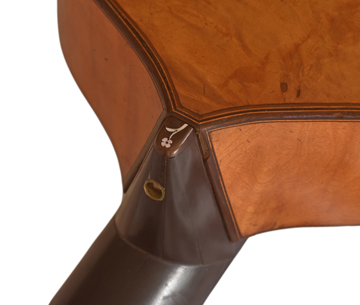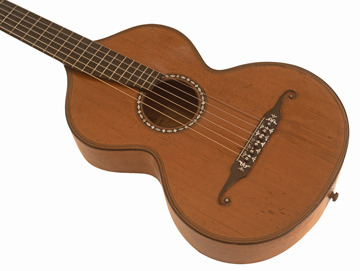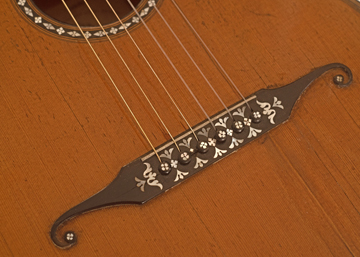A
Virtual Museum
of
Vintage Martin
Guitars
and free
e-book
Illustrating and Exploring the Development
of the Martin
Acoustic Guitar
Created by Folk and Roots Music
Photographer
Robert Corwin
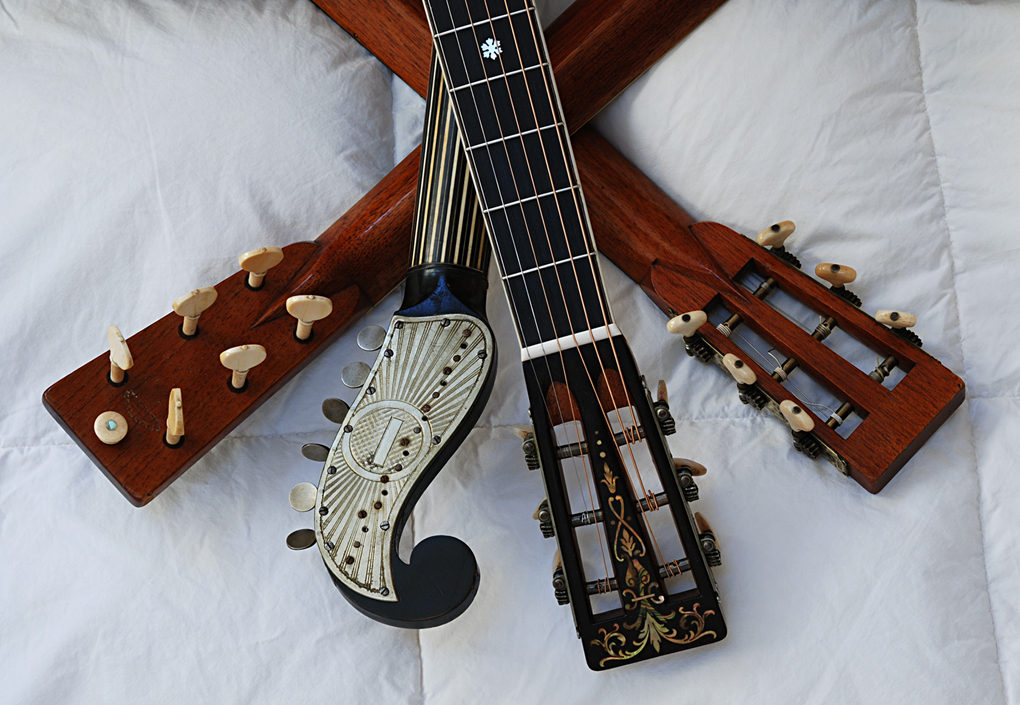
"perfecting the art of 'guitar porn' ...
This site is an amazing labor-of-love, quite possibly the most
in-depth, photo-intensive look ever at old, pre-war (and in many
cases antique) Martin guitars … All online and for free."
--Jason Verlinde
The Fretboard Journal
"Without any hesitation I can say that in my opinion, the website
that Robert has created is the most valuable source of information
on Early Martin Guitars in existence today, in or out of print."
Bill Cappell, Early Martin Researcher
Robert's photographs can also be seen in the books "Martin
Guitars, a History"
and "Martin Guitars, a Technical Reference" by Johnston, Boak
& Longworth
` ` ` ` ` ` ` `
` ` ` `
A Note About this Web Site...
I've chosen to present this information on the web for free,
rather than publish a printed book, to make a comprehensive
resource available
...at any time,
...any place in the world,
...even on your smartphone,
...regardless of your means.
Publishing on the web allows me to show you the latest information
immediately, without waiting for publication, without missing
information obtained after a book is
published, or including information found to be
obsolete. Fortunately, careful choices have allowed me
to self-fund this project and share the results without charging.
If I should ever decide to publish a physical book, I still have
no plans to replace these free web sites.
I've learned that the instruments produced under C.F. Martin Sr.
in his first dozen or so years in America and his 22 year old
grandson Frank Henry Martin, who led
the company for 67 years, during the productive Hawaiian boom of
the teens, through the influential depression era, to the "golden"
pre-WWII years, virtually define
the evolution of the acoustic guitar as we know it today, so I've
focused on collecting and studying these transitional
guitars.
Martin's greatest achievement may have been listening well.
Virtually all of the greatest advancements in the development of
the acoustic guitar were conceived of not
at the Martin factory, but at the suggestion of Martin's
customers. Martin's longtime distributor, John Coupa, lived
in the classical world, who's players were attracted
to the influential guitars of Spain. Madame DeGhoni
commissioned guitars with prototypical X bracing, a necessary
precursor to steel strings, from both Martin and
Schmidt & Maul. Steel strings first appeared on the
Hawaiian guitars commissioned by the Southern California Music
Company. The modern guitar shape is the result
of the neck meeting the body at the 14th fret as requested to
attract former banjo players by Al Esposito of the Fischer Music
Stores. The Dreadnaught body style was
suggested by Harry Hunt of the Ditson Stores. Martin Shop
Foreman John Deichman helped realize many of these ideas.
Having guitars in hand has allowed me to to let the guitars speak
for themselves, observing, measuring, and documenting, with
exterior photos and images that
allow us to take a virtual walk through their interiors, and to
present as often as possible the results of direct observation
rather than speculation and debatable opinions.
Simple observation has allowed me to correct errors in several of
the most important elements of the narrative as presented by some
major books on the subject, leading
me to question who was responsible for building the first Martins,
adapting fan bracing, for "inventing" X bracing, and proposing the
14 fret neck design that informs
the shape of the modern guitar.
C.F. Martin & Co. has produced exquisite guitars, and I've
been fortunate to assemble a number of the most beautiful, but I
realized early on that any attempt at serious
research should also take the less expensive "bread and butter"
examples seriously, rather than fall into the trap of relying on
the "eye candy" of less typical "presentation
guitars" merely because they impress. Unfortunately, while
many more of the affordable guitars were produced, they were far
less likely to survive their tough years.
I'm also fortunate to have lived life as a President's Fellow in
Photography and Design at Rhode Island School of Design, in over
50 years of photographing musicians,
and as a professional designer with a background in publishing, so
I've worked to apply my learnings to set a higher bar for graphic,
vivid detail photos that I'm flattered
to find have been emulated already. Producing the photos
myself has also allowed me to avoid the industry funding used to
help other projects cover the significant costs
of paying a commercial photographer, keeping this project
independent and free of outside influence.
While many of the foremost experts on vintage Martins are friends,
and I owe thanks to all of them, I've been careful to avoid owing
favors to friends, or to anyone in the
industry, that might interfere with my objectivity, or keep me
from presenting my findings fully, letting the chips fall where
they may, and not having to worry about who
might be offended and who will "look good".
www.earlymartin.com
contains 67 chapters.
www.vintagemartin.com
is 139 chapters and growing, including more detail, photos, and
free, full-size downloadable diagrams
than any book could include.
I don't believe that producing a web site rather than a book is a
compromise in any way.
More than simply a free e-book, I would not be surprised to see
this inclusive personal experiment of creating in public to become
commonplace in the future.
This web site will always be a work in progress. Not all
sections are complete, and more may appear. Hopefully, all
of the links are working now. I've reorganized the entire
site and the pieces continue to come together, but there are still
holes and place holders. Feel free to enjoy what's here, and
check back for further additions, refinements,
and corrections as you wish. Thanks to your suggestions,
I've added an index. I've also added more bracing diagrams,
which are now cleaned up nicely thanks to the CAD
skills of luthier Per Marklund in Sweden. I look forward to
adding specific thanks to the many other friends and experts who
have helped make this web endeavor possible,
along with links to other helpful resources. On this
platform, the possibilities are limitless.
I recently presented and videotaped a workshop in partnership with
Fretboard Journal, with the help of friends including Noel "Paul"
Stookey of Peter, Paul & Mary, playing
a number of my guitars to demonstrate the differences in the
sounds of their various features. I hope to add this as well
as other videos and sound clips to the web site soon.
I've also purchased several other
wonderful early Martins that I'll be adding soon, including the
unique and legendary double body Model America, and another fancy
transitional early Martin with experimental bracing.
No project is
perfect. Perhaps my biggest asset is having you as partners,
in daily communication, alerting me to new information, and
providing an unprecedented team of proofreaders, rather than have
me grit my teeth over a newly published book filled with typos
that will annoy forever. :) Thanks!
I thought you might want to take advantage of what we have so far.
Please let me know what you think.
Robert Corwin
- Please note -
Yes, this is a work in progress, as promised! I'm in the
process of adding several exciting new instruments to this web
site.
The new chapters for these instruments have not all been
completed yet, so the associated links are not all operable at
this time.
I also have not yet adjusted the index to reflect the new
added chapter numbers, so the index is not now accurate.
I hope to finish making these changes in the coming
days. Thanks for your patience and understanding in the
mean time!
January 1, 2020
`
` ` ` ` ` ` ` `
` ` `
One of the most gratifying aspects of this project has come in the
form of notes received from luthiers I admire telling me that the
site has provided information useful for
the restoration or repair of vintage instruments or the building
of innovative new ones.
"The internet is another good source of reference. One
website with good close up photos of vintage instruments... that I
particularly like is vintagemartin.com.
It is possible to extrapolate measurements from some of these
photos if you already know the dimensions of other details in the
photo. That type of thing can be very useful..."
Guild of American Luthiers, 2011 Convention Keynote Lecture by Joe
Konkoly, Head of repair at Elderly Instruments.
Please let me know how the site may be more useful in the future.
` ` ` ` ` ` ` `
` ` ` `
Start here if you're looking for help Identifying C. F. Martin Acoustic
Guitars
A Martin Timeline
` ` ` ` ` ` ` ` ` ` ` ` ` ` ` `
FREEBIES!!!
~ Download the above headstock image as a 1680 pixel
Screensaver,
free for your personal use as my gift to you! ~
~ Click on the headstock image below and download a hi-res file to
create a high quality 11" x 14" photographic print, suitable for
framing, free for your personal use as my gift to you! ~
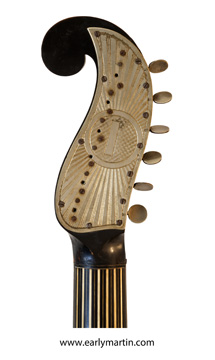
~ Download any of nineteen full size 1:1
diagrams,
with precise measurements of fifteen important early Martin,
Panormo, Recio of Cadiz, Schmidt & Maul guitars,
a 1917 Martin/Ditson Standard "baby Dreadnaught", a 1929 12 fret
000-28, an early 1930 OM-28, and a 1944 000-18, all free for your
personal use. ~
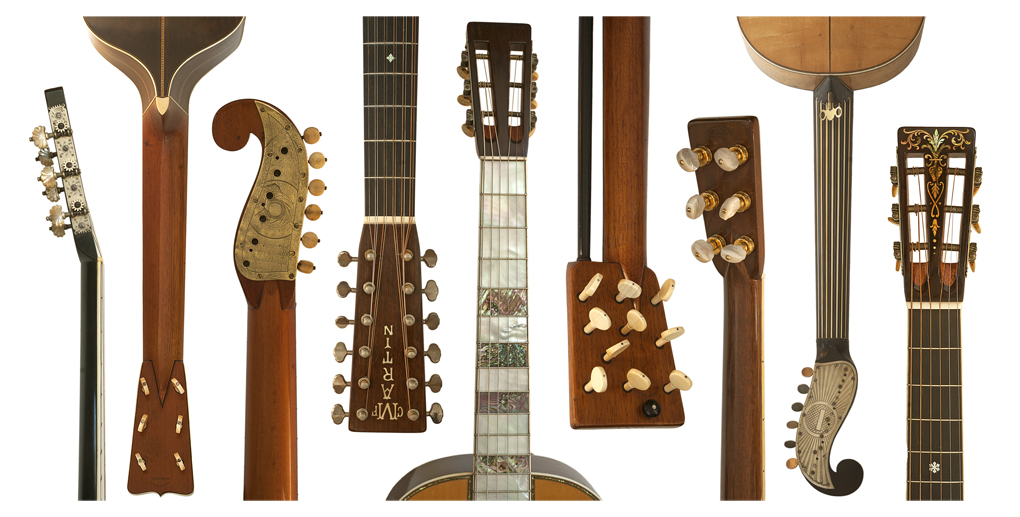
` ` ` ` ` ` ` ` ` ` ` ` ` ` ` `
Obtaining Proper Permits for Shipping Vintage
Instruments Overseas from the USA
Complying with
The Convention on International Trade in Endangered Species of
Wild Fauna and Flora (CITES)
and the Endangered Species Act (ESA)
' ' ' ' ' ' ' '
' ' ' ' ' ' ' '
~ CLEANING HOUSE ~
I absolutely love these, but I really do need to make just a
bit of room for new ones.
Instruments
for Sale
' ' ' ' ' ' ' '
' ' ' ' ' ' ' '
' '
' ' ' ' ' ' ' '
' ' ' ' ' '
' '
' ' ' ' ' ' ' '
' ' ' ' ' '
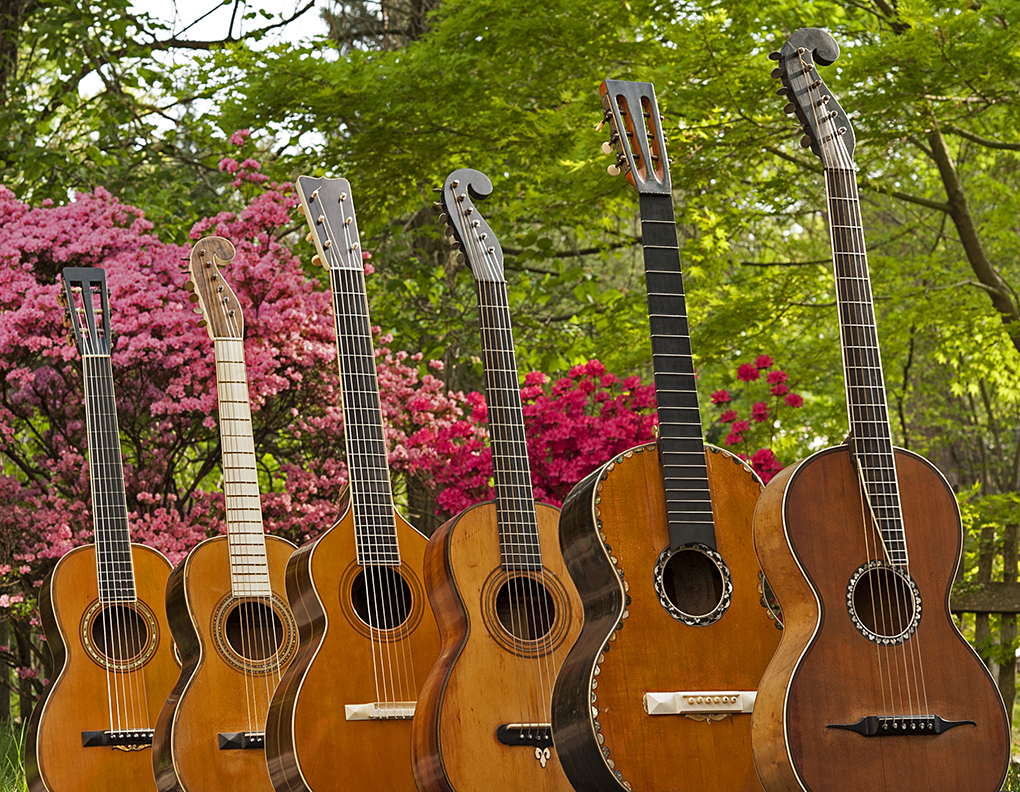
' ' ' ' ' '
' ' ' ' ' ' ' '
' '
~ THE EVOLUTION OF THE MARTIN GUITAR ~
' ' ' ' ' '
' ' ' ' ' ' ' '
' '
~ PART 1 ~
~ The Nineteenth Century ~
~ EARLY C. F. MARTIN INSTRUMENTS ~
Before the Styles Were Defined
Preface.
Stauffer "Renaissance" Style Legnani Model
Guitar
Long
before C.F. Martin came to New York from
Markneukirchen, Saxony and established his music store
on the lower East Side of New York City,
Martin
is said to have apprenticed in the acclaimed workshop
of Johann Georg Stauffer of Vienna, builder of the
Stauffer "Legnani" Model,
perhaps
the most modern of European guitars.
Ironically,
early Martin guitars are known for their "Stauffer
headstock", a distinctive headstock with six tuning
machines in line on a single side of the
headstock,
as emulated today on Fender guitars, and which were
referred to by Martin as "Vienna
Gears". In actual fact, more
Stauffer guitars have a paddle
shaped
headstock with ebony friction pegs than
what has come to be known as the
"Stauffer" head.
Stauffer
guitars typically have a thin, wide "figure 8" shaped
body with an upper bout more equal in size to the
lower bout, also seen on the earliest
Martin
guitars, as opposed to the guitars of Spain, with a smaller upper
bout on a narrow body, as later adopted by Martin and
still prominent today.
The
unique one of a kind "Renaissance" Style Stauffer
guitar seen here, with a body that flows seamlessly
into the neck, is clearly the model for the
unique
one of a kind "Renaissance" Style Martin guitar seen
below, so we're lucky that both have survived.
Chapter
1.
Martin Stauffer Style Guitar
The history of the Martin begins
with this guitar. Several books show this guitar,
labeled as a Stauffer, along with what has been considered to
be the
earliest
existent Martin guitar, to show the influence of the
Viennese Stauffer workshop, where Martin once
apprenticed, on the first guitars built by
Martin in the new world. A large photo of this
instrument is displayed in the Martin Museum next to the early
Martin to illustrate this connection.
When I compared the two guitars side by side and
photographed their interiors, the DNA emerged of two
near identical siblings, obviously conceived
by the same hands at the same time with minor cosmetic
variation, a fact now
accepted by other Martin experts.
As you'll see as you read further, it was
typical in the early days of Martin, when they had an
order for one guitar, to build a second with minor
variation in trim. The two
instruments feature
small, shallow,
figure-eight shaped
bodies
with large
upper bouts
and identical
dimensions, and
spruce tops and maple veneer backs over spruce
with
maple sides. Both have Stauffer style
headstocks with Vienna gears, necks with inlaid
stripes of ebony and ivory, raised angled
fretboard extensions,
abalone soundhole
designs set in mastic,
and
intricate ivory and ebony ice cream cone
heels with clock key adjustments and hand
shaped neck blocks with
identical hardware. Each
guitar is ladder braced with a similar "buttress"
under the fretboard extension of each.
This guitar has no stamps or label, adding to the belief that it came from the
workshop of Stauffer, not Martin. Once I recognized that
it came from
the same hands as the Martin, the question was raised of
whether this guitar and the Martin stamped example might both
have been built by others in Europe,
and one was imported by Martin, with the Martin stamp
added, along with a label proclaiming Martin as an "importer
of musical instruments". Perhaps both
were made by a fellow immigrant living in New York City.
Mr. Martin, after all, was a busy owner of a Manhattan music
store. Martin's records, however,
show that Martin imported only more affordable guitars, and Martin
moved to this country with his friend Heinrich Schatz, a
well trained luthier who worked in
Martin's New York shop, and who's later work was similar
to and every bit as skilled as the finest early
Martins. So it's likely that these
two guitars were
both built in Martin's shop after all.
It's traditionally been assumed that all early C.F. Martin
guitars were built by C. F. Martin. We now know that Mr
Schatz, at a minimum, had a hand in building
the guitars. Schatz was a fine builder, and Martin a
busy shopkeeper. Did Schatz do all the building of the
early fine Martin guitars? Perhaps we will never know.
These two guitars, if not typical, are the pinnacle of
guitars offered by C. F. Martin when he first came to
America.
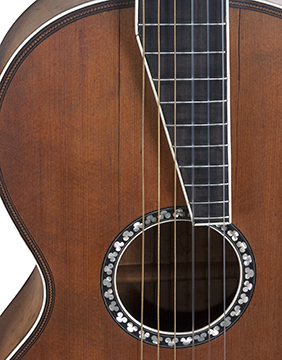
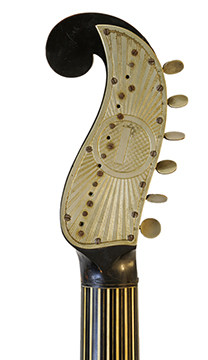
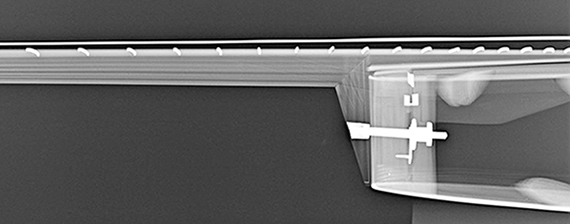
Illustrated in
Washburn & Johnston, "Martin Guitars: An Illustrated
Celebration of America's Premier Guitarmaker":
"The similarities between these two guitars are
startling... Note the almost identical bridge, soundhole
rosette, and angled cut at the end of the fretboard,
as well as the adjustable neck with fretboard floating above
the soundboard. Both guitars also have maple backs
and sides, though Martin would soon
shift almost exclusively to rosewood."
Illustrated in Gura, "C. F.
Martin and His Guitars, 1796-1873"
Illustrated
in Bacon, "History of the American Guitar"
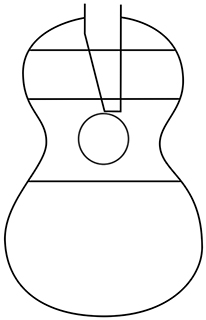
Chapter
2.
Early C.F. Martin
"Ferrani" Hudson Street Viennese Style Guitar
While
the earliest Viennese influenced Martins had rather small
figure-eight shaped bodies with large upper bouts, the "Hudson Street label" Martins
built later in the
1880's could
be surprisingly large and deep guitars reminiscent of the
later Gibson Nick Lucas. These guitars, like their
Viennese predecessors, had simple ladder bracing.
This
guitar appears to be in the Style Mr. Martin referred to as a
"Ferranti".
"In October, for
example (Coupa) ordered two "small DeGoni” at $20 each, two
large ones with pegs, and one "Ferranti"...The "Ferranti"
was named for another well known
player, Marc
Aurelio Ferranti, guitarist to the king of Belgium.
His instrument was also described as large, of a more
"circular” form - that is, with both bouts about the same
width.”
Gura, p 76.
Coupa to Martin, New York, October 15, 1849.
While
a typical Martin of the period might be 11 5/8" wide and 3
1/4" deep, the Ferranti Martin is 12 5/8" wide and 4 1/4"
deep, close to the depth of the famously deep Nick Lucas.
This guitar is typical of what
Martin was building in the late 1830's before leaving New
York for Pennsylvania. While most people associate
the Viennese influenced Martins with
Stauffer style headstocks with Vienna gears, many of these
originally had slotted headstocks with machines, some of
which have been improperly replaced due to
misunderstanding.
While the back and sides
appear to be Brazilian rosewood, the back is in fact a
rosewood veneer over spruce. Most early Martins
were built in this fashion, with
the customer's choice of a variety of quality hardwood
veneers over either spruce or mahogany.
Most of the Hudson Street
Martins have a top border of "thumbprint" inlays as well as the "herringbone"
trim that has distinguished Martins for many years.
The inlays may
have been crafted from halves of button blanks from
neighboring lower East Side garment dealers.
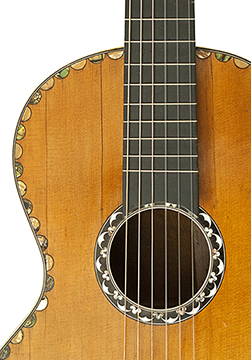
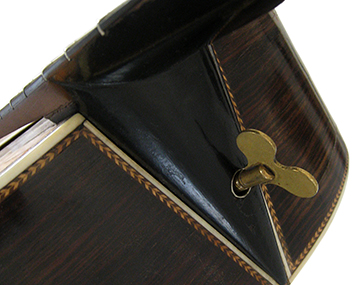
Illustrated in
Washburn & Johnston, "Martin Guitars: An Illustrated
Celebration of America's Premier Guitarmaker":
"Martin ledgers
from the 1830's suggest that most of C.F. Sr.'s guitars were
small and plain. The eye catching inlays on this fancy
model probably
ensured it's survival, while most of the simple guitars from
this period were discarded long ago."
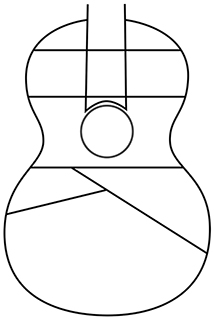
Chapter
3.
Martin & Schatz Guitar
One of
the most significant early
Martins, this Martin &
Schatz labeled guitar resided
in a glass case at the new
Martin factory in the years
preceding the addition of a
formal Martin Museum.
During
his first decade of operations in New York City,
C. F. Martin's discovery of the fan braced
guitars of Cadiz, Spain greatly influenced the
direction of the design of his guitars.
Built in the old world tradition with Viennese gears,
and one of a handful of Martins
with an ivory fingerboard and a small
few with an ivory
shield shaped bridge, this
was also one of the first one
or two Martins built with a variation of fan
bracing and the narrow early Spanish
"plantilla" or body shape.
This instrument was built with a rosewood veneer over mahogany
and rosewood sides.
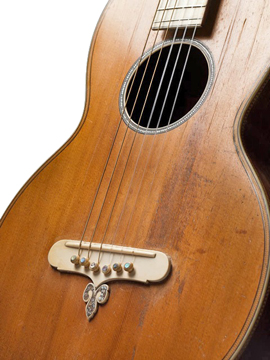
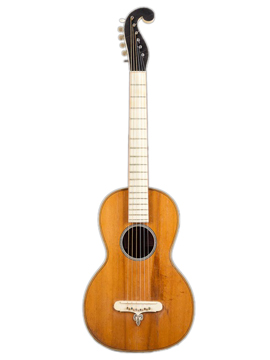
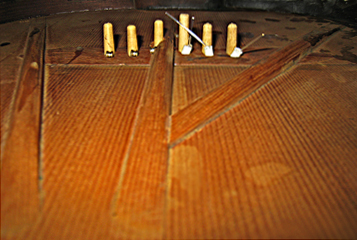
Illustrated
in Gura, "C. F. Martin and His Guitars, 1796-1873"
Illustrated in Washburn & Johnston, "Martin
Guitars: An Illustrated Celebration of America's Premier
Guitarmaker".
Illustrated in "Inventing
the American Guitar: The Pre–Civil War
Innovations of C. F. Martin and His
Contemporaries", where a diagram erroneously
shows a
significantly different bracing pattern than
the photo above shows to be true, and the
narrative implies an evolution from ladder to
fan bracing, while fan bracing
was not "evolved" by Martin, but copied from
the Spanish guitars he observed.
Illustrated
in "The
Martin Story: A Brief History of the Martin
Guitar Company", .C.F Martin & Co.
Illustrated in Carter "Acoustic Guitars
and Other Fretted Instruments".
Illustrated in
Bacon, "History of the American
Guitar"
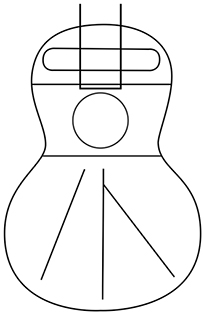
Chapter
4.
Jose Recio, Cadiz
Guitar
The developing shape of the Martin guitar, with a smaller
upper bout, was influenced by the guitars of Cadiz,
Spain. The "Spanish" style Martin guitars of
the 1840's copied many of the features of guitars of Cadiz,
including fan bracing, the cedar neck with thin curved heel,
square headstock with "volute",
tuning pegs, "Spanish foot", two piece
sides, rosette with thinner outer rings, and tied bridge with
ivory or bone inset.
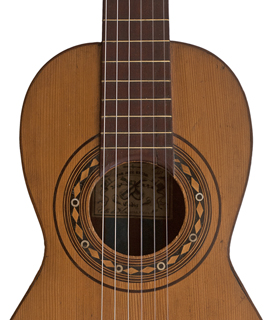
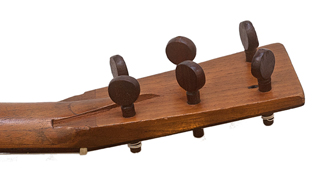
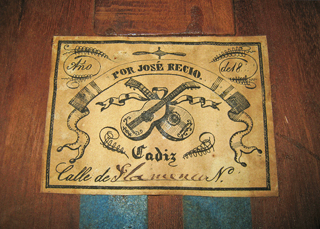
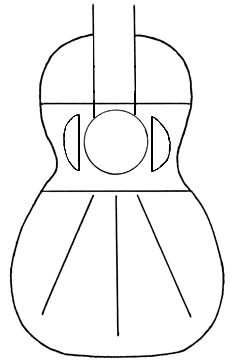
Chapter 5.
Martin
& Coupa Brazilian "Tigerwood" Guitar
Once
the Martin family moved from New York City to rural
Pennsylvania in 1838, distribution of the guitars
remained in New York, handled by guitar teacher John Coupa,
and the guitars were either
affixed with a "Martin & Coupa" label, or
continued to be stamped "C.F. Martin, New York".
This
is a typical early Martin parlor guitar, showing a mix
of Viennese and Spanish influenced features:
Still with the Stauffer Style headstock and Vienna
gears, ebonized neck
and "ice cream cone" heel, combined with Spanish fan
bracing, an early precursor of Martin's faux Spanish
foot, extending the width of the upper bout, and an
early version of
Martin's typical Spanish influenced body shape, with a
smaller upper bout than the Viennese influenced
guitars, and a flatter base of the lower bout than is
found on later Martins.
This instrument has
been noted in several books as an early illustration
of Martin's use of Hawaiian koa wood, long before koa was first thought to have
been used during
the Hawaiian craze
of the teens.
Recent testing
has shown this wood to in fact be Goncalo
Alves from Eastern Brazil, commonly referred to
as "Tigerwood".
The back is a Goncalo Alves
veneer over
mahogany.

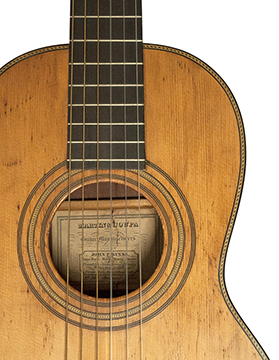
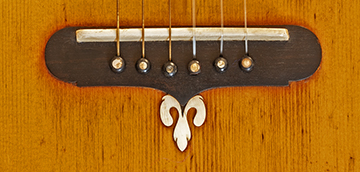
Illustrated
in Washburn & Johnston, "Martin Guitars: An
Illustrated Celebration of America's Premier
Guitarmaker":
"You
don't often find Hawaiian koa on
mid-nineteenth-century guitars; in fact, you don't
find much koa on anything at that early date.
Around 1915,
when the Hawaiian music craze swept the nation, Martin
began to make lots of instruments from this beautiful
wood, but one can only speculate
why C.F. Sr. chose to try it on this Martin &
Coupa from the 1840's."
Illustrated
in Carter "Acoustic Guitars and Other Fretted
Instruments":
"Stuck
over the Martin & Coupa label is one indicating
that the guitar was "Sold by John F. Nunns".
Martin & Coupa claimed the largest assortment of
guitars that can be found in the United States."

Chapter 6.
Martin Bird's Eye Terz
This guitar was likely built at close to the same time as
the Tigerwood Martin and Coupa above but with three
differences. It is a smaller "Terz" guitar.
It was built with a bird's eye maple veneer over mahogany
rather than Goncoa Alves. And it has a single
Martin, New York stamp in place of the Martin & Coupa
label.
The Terz is a small guitar, still made by Martin today,
and made popular more recently by Marty Robbins.
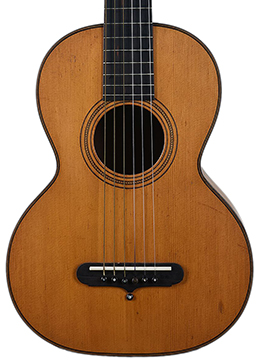
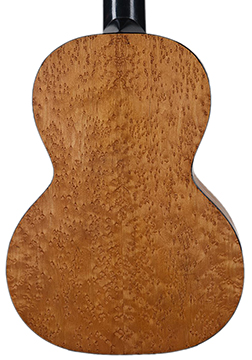
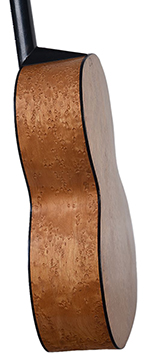
The dimensions are:
22 1/8" scale
18 1/4" body length
11 3/8" body width
32" total length
3 3/8" depth at upper bout
3 3/4" depth at lower bout
1 3/4" nut width
2 5/16" string spacing
4 29/32" wide bridge
6" x 1 7/8" x 3" headstock
3 1/4" soundhole
Ebony pegs
Ice Cream Cone heel
Black binding
Broad foot under wide rounded neck block
Three rounded back braces at 4", 3 3/4", 3 3/4"
Three strut fan braces
Bridge plate
While this guitar was build at approximately the same time
as the Martin & Coupa, the Martin & Coupa label
was used only on guitars distributed from New York by John
Coupa while Martin was also selling a smaller number of
guitars directly from the workshop at their new home in
Cherry Hill, Pennsylvania.
Chapter 7.
Martin & Coupa
Spanish Style Guitar
This example epitomizes the Martin
guitar at a critical point in it's evolution. The
"Spanish" Martin is a distinct style with specific features
clearly
showing Martin's awareness of the pre-Torres guitar of
Spain. This guitar retains features of Martin's earliest
Viennese influenced guitars,
including the "Stauffer Style" headstock with "Vienna Gears",
while adding features of the Spanish guitar.
This fine example of perhaps the earliest of Martin's versions
of a Spanish guitar has many prototypical Spanish
features: cedar neck with
elegantly curved Spanish heel, Spanish style interior false
foot, tie style bridge with ivory inset, fan braces, two piece
rosewood sides with simple
lengthwise center strip dividing the two pieces, and both
bindings and simple back strip with straight lines made
of holly extending into the heel.
This guitar is also an early example of features which would
become hallmarks of Martin design for years to come, such as
the ebony pyramid style
bridge, and Martin's version of the Spanish body shape with a
smaller upper bout than the Viennese influenced guitars.
This could be the earliest Martin we've seen to have solid
Brazilian rosewood backs and sides in place of a back of
rosewood veneer.
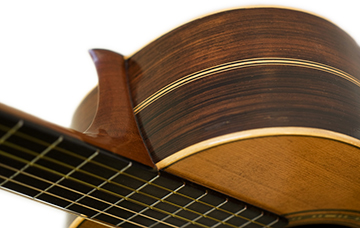
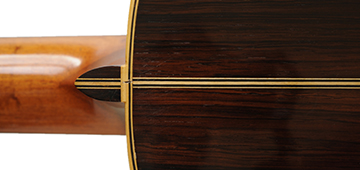
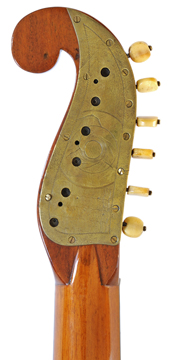
Illustrated in Evans, "Guitars: Music,
History, Construction and the Players, from Renaissance to
Rock"
While interviews related to a recent
museum exhibit of early Martin guitars infers that the
"Spanish Connection" is a recent discovery, the
importance of this instrument in illustrating the significance
of the influence to C.F. Martin of the "Pre-Torres' guitars of
Cadiz, Spain was
clearly
recognized here by Evans, in these words published 46 years
ago, in 1977, and reprised in the 1997 writing of Washburn and
Johnston:
"This instrument has a combination of features that is, to our
knowledge, unique on a Martin guitar. The head design is
similar to that used by
Martin in the 1830's, with the tuning machines concealed under
a metal plate and buttons on one side, after the manner of
Stauffer. The body,
however, does not have the Stauffer-inspired, wasp-waisted
shape of the 1830's, but is closer to the mature Martin style
of twenty years later.
The shape suggests strongly that Martin had had the
opportunity to examine a Spanish-made guitar of about 1840,
and was
experimenting with Spanish-style construction."
"This supposition is reinforced by the presence of Spanish
features such as we have seen on no other Martin guitar,
including simple fan
bracing with three radiating struts, and a Spanish head and
slipper foot into which the sides are slotted. The
division of the rosewood sides by a
narrow decorative hardwood strip is another feature borrowed
from the nineteenth-century Spanish guitars. The
presence of this strip weakens
the sides; to give them strength, Martin fitted several
vertical braces into which the cross struts of the top and
back are notched, framing up the body."
"The design of the bridge is very modern for it's date.
In shape it conforms to the "pyramid" bridge pattern used by
Martin throughout the latter
half of the nineteenth century and the first quarter of the
twentieth. But this is one of the very few
nineteenth-century Martin guitars to be made with a
tied rather than a pin bridge. The strings pass over a
broad, backward sloping ivory saddle-piece before being
secured at the rear of the bridge."
"This guitar proves that C.F. Martin was one of the few makers
outside Spain in the early nineteenth century to be aware of
the possibility of fan strutting
on the guitar, and that he experimented with it before
developing his own famous X-bracing system. It shows the
American gut-stringed guitar, the
ancestor of the steel-sting guitar, at a critical point of
it's evolution, about to break away from the diverse European
influences to which it owed it's beginnings."
Illustrated in
Washburn & Johnston, "Martin Guitars: An Illustrated
Celebration of America's Premier Guitarmaker":
"The most
interesting parts of this Martin & Coupa are what you
can't see. The neck has a Spanish-shaped heel, with the
sides slotted into a
neck block with an interior "foot". The top is also fan
braced, a feature this guitar shares with several other Martin
& Coupa instruments. Other small
details from this experimental period at Cherry Hill strongly
suggest that C.F. Sr. was turning away from Northern European
guitar design and
incorporating ideas found on Spanish instruments predating
guitarmaker Antonio Torres's guitars.
Illustrated
in "The Steve Howe Guitar Collection"
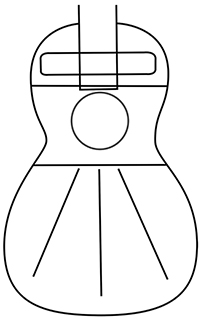
Chapter
8.
Schmidt
& Maul Spanish Style Guitar
The Martin & Coupa above has been touted as containing
a singularly unique combination of features not found on
any other known Martin guitar,
including elements showing Martin's Viennese and Spanish
influences, as well as the beginnings of his own
style. When I purchased this 1844 Schmidt
and Maul guitar at auction from Christie's, I was shocked
to discover that it contained every single one of the
unique elements recognized by Evans in the
Martin & Coupa above, including Viennese gears and
Spanish fan bracing, split sides with marquetry, simple
holly borders and back strip following through
the Viennese Style headstock with gears, and Spanish Style
cedar neck with a distinctive raised volute that has been
flattened to fit under the gear plate. This
guitar shows
us that
Schmidt &
Maul were also
influenced by
Spanish
guitars at an
early
date.
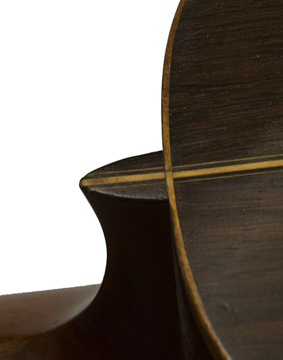
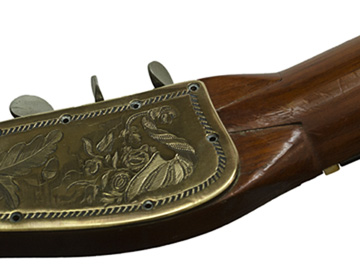
It is
inconceivable
in the small
community of
German
immigrants that
one
builder would
have so
blatantly
"ripped off"
the work of
another,
especially
considering
that Schmidt
and Maul were
formerly both
employees of
Martin, and retained
a friendly
relationship
into the
1850's. It
was likely
John Coupa, Martin's
partner,
distributor,
and a
classical
guitarist who
introduced
Martin to
Spanish
guitars, also
introduced the
Spanish
guitars to Schmidt
& Maul,
who
worked
upstairs at
the same
address as
Coupa.

Chapter 9.
Early
Transitional Viennese/Spanish Style Martin & Coupa Guitar
Some folks studying early Martin guitars make
a point of presenting the guitars in chronological order
to establish a sequence of events. This can be a
difficult
endeavor with somewhat unsatisfying results. Once
Martin introduced a new feature, it was added to his
menu of available options for customers to choose from,
so
not only do features show up far after one would have
thought them to be obsolete, but guitars keep popping up
with features that we thought to have come far later.
This guitar has some features associated with the Martin
& Coupas, including the ebony pyramid tie style
bridge with inset ivory saddle, the "shelf" style of
"Spanish foot", and five strut fan braces.
The wide, open rosette is more reminiscent of Panormo or
the guitars of Cadiz, Spain. This guitar has a
Viennese
influenced ebonized neck with "Stauffer Style" head with
Vienna Gears and ice cream cone heel. We see the
herringbone border on the sides that are usually
found on Martin's earliest guitars from the Hudson
Street days. And we are surprised by a wide
marquetry top border of the style generally found on a
Style 34,
after Martin's styles were established in the 1850's.
Not surprisingly this guitar shares features with some of
Martin's simplest guitars, while the herringbone side trim is
seen on Martin's most decorative guitars,
and the delicate back border is only seen on a handful of
early Martins. The back is rosewood veneer over
mahogany.
By comparison, the Spanish Martin & Coupa above looks
similar from the front with it's Spanish shape, "Stauffer"
head, and ebony tie bridge with inset,
but has an "earlier" three strut fan, which generally defines
the era, and a later Spanish heel, while
this guitar has the earlier ebonized neck with ice cream
cone heel and herringbone side trim, and a
later style of marquetry.
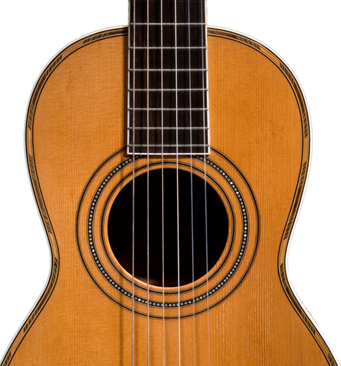
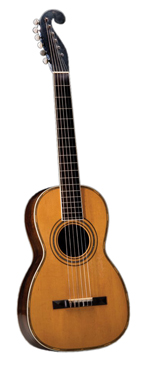
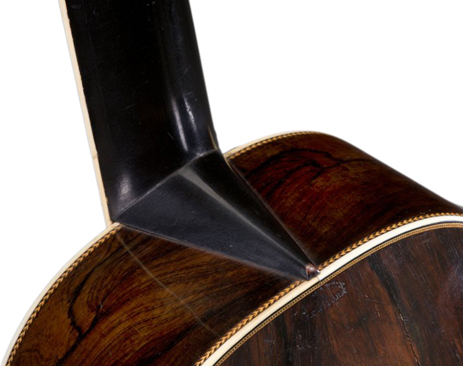
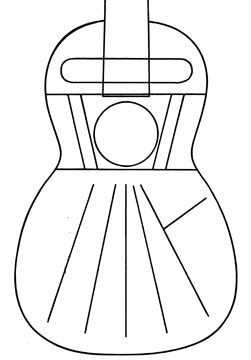
Chapter 10.
Martin Spanish Style
Guitar
This guitar is a uniquely fine example of
Martin's version of the Spanish guitar, with many of the
typical features: cedar neck with elegantly curved
Spanish
heel, large, square headstock flared to a wide end, with pegs,
nickel silver nut, Spanish style interior false foot, tie
bridge, fan braces, two piece rosewood sides
with decorative side filets and a decorative lengthwise center
strip with marquetry dividing the two sections, and back with
rosewood veneer over mahogany.
With the fancy appearance of perhaps the most jewel-like
Martin "presentation" guitar existent, with a top border of
pearl diamonds set in mastic, and a
version of one of the three basic pearl diamond-adorned soundhole
designs with two rows of
glittering tiny
pearl diamonds
surrounding a solid band of colorful
abalone, this example was clearly built to be played, with a
large, long scale, modern feeling neck, which gives this
guitar the feel in-hand of a much larger guitar.
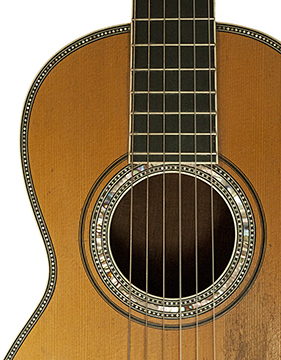
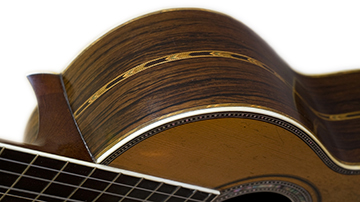
Illustrated in
Gura, "C. F. Martin and His Guitars, 1796-1873":
"This instrument
has rosewood sides and back (laminated); marquetry on back and
side edges and through the center of it's sides; pearl trim
around the
center of it's sides; pearl trim around the top, and an
abalone rosette. Note in particular the beautiful
abalone soundhole and top trim, found on Martin's
highest-style guitars, and the ivory tie bridge."
Matt Umanov,
Umanov Guitars, New York:
"Most
interestingly, it also has a longer scale; at 24.5" it is
nearly that of a grand concert size Martin. This
suggests possible construction for concert use,
as it gives the guitar an amazingly sonorous tone, far out of
proportion to it's size."

Chapter 11.
Martin
Renaissance Style Guitar
This
guitar shares many features with the 1840's Spanish
Style guitar above, including the ivory bound headstock
with pegs and thin ebony lines
delineating all edges of the headstock, volute and neck,
cedar neck, elegant heel, nickel silver nut, fan
bracing, identical ivory tie block bridge, 2 piece sides
divided by a longitudinal strip of marquetry, details of
internal construction, and a long modern feeling
neck. This unique "Renaissance" shape,
however, can be seen on only a handful of early Martin
guitars.
But the unique
details go further than that. This is the only known
example of a Martin with sides tapered to fit the contour of
the neck heel in a
most elegant fashion. The neck is a full 2" wide, with a
24.75" scale, and this is one of only two Martins known to
have a unique peak at the
tip of the ivory bound headstock. Besides being one of
the most unusual Martin examples known to exist, the condition
is breathtaking, all original
and looking like an almost new guitar.
This is another early example with solid Brazilian rosewood
backs and sides in place of a rosewood veneer back.
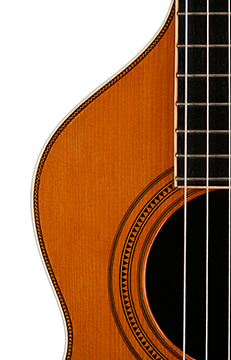
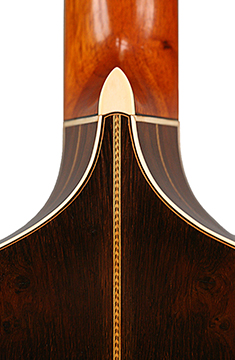
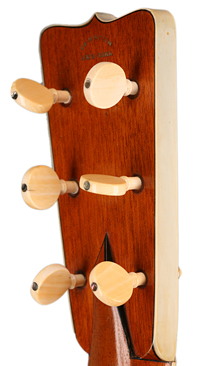
Richard
Johnston, co-author "Martin Guitars, a Technical Reference":
"This is the earliest Martin guitar I have seen in many
years, and without doubt the most unusual. Words like
“unique” and “extremely rare” get tossed
around frequently when describing vintage guitars, but in
this case we’re not exaggerating. Only seven of these
unusual “Renaissance” shape Martins
have surfaced to date, and only this one has the sides
tapered to fit the contour of the neck heel."
Illustrated
in Washburn & Johnston, "Martin Guitars: An Illustrated
Celebration of America's Premier Guitarmaker":
"This elegant peghead has been seen on only a handful of
early Martins... The ivory sides... later evolved into
a thin border on only the uppermost
edge of the peghead."
"The compound curve of the guitar where the sides meet the
neck is sure to inspire admiration from any serious
woodworker...no other Martin
guitar has surfaced in which the sides form a continuous,
smooth transition into the neck. The low-profile
shoulders would make playing in
upper positions on this guitar almost as easy as on a
cutaway guitar.
Please note: I'm proud to say that the "Renaissance
Martin" shown above, as well as it's "likeness" or image,
are the sole property of the Corwin Collection.
Sadly, numerous images of this important guitar were
knowingly reproduced in the book "Inventing the American
Guitar: The Pre–Civil War Innovations of
C. F. Martin and His Contemporaries" by Szego and Shaw
without proper attribution, and without obtaining the
necessary permission requested and required
to legally reproduce it's image for commercial use.
The image and "likeness" of this guitar are the
sole property of the Corwin Collection, and may
not be legally reproduced without permission.
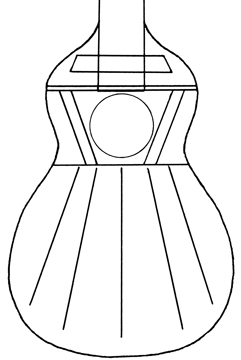
Chapter 12.
Martin & Coupa "Small
DeGoni" Hybrid X Braced Guitar
It
is believed by
many that
Martin
developed
X_bracing.
X braced
guitars, in
fact, were
ordered by
Madame De
Ghoni from
both Martin
and Schmidt
&
Maul.
The similarity
of the
treatments
show more than
similar
interpretations
of the same
request.
An
investigation
into the
development of
X bracing
on Martin and
Schmidt &
Maul guitars
leaves us
wondering
again about
the
relationship
between the
two firms.
Besides
Henirich Schatz, we now know
that Louis Schmidt was also
an employee as early as 1834
or 1835. The longer we
study this guitar, the more
we
must wonder if Mr. Maul also
played a large part in
building early Martin
guitars, and perhaps
continued to consult with
Martin after Martin left New
York
and moved to Pennsylvania,
playing much of the role in
the development of X braces
and the modern guitar, that
Mr. Deichmann played in the
development
of the 14 fret guitar and
the Martin
Dreadnaught. Schmidt
& Maul were certainly
familiar with Martin
guitars, and if a customer
of John Coupa returned a
guitar
for repair, it certainly
would have been more
convenient to deliver the
guitar upstairs for repair
rather than return it to
Nazareth!
This Martin was built with what I believe was the first
experimental variation of X-bracing, appearing at about the
same time on a handful of Martin and Schmidt
& Maul guitars. One Schmidt & Maul, not
necessarily the earliest, is dated 1845, while the example
produced by Martin for Madame DeGhoni is dated 1843.
"Coupa could be much more
specific in his requests. In October, for example he
ordered two "small DeGoni” at $20 each, two large ones with
pegs, and one "Ferranti". The “DeGoni"
was
a model named after Delores Nevares DeGoni, a well-known
performer who occasionally appeared on the stage with Coupa.
When she came to the United States in 1843 she
brought
a large patterned Spanish guitar, copied by both Martin and
Schmidt and Maul, which thus may have provided Martin with the
incentive for producing some guitars
in
what was termed the"Spanish style”.
Gura, p 76. Coupa to
Martin, New York, October 15, 1849.
This guitar appears to be what Martin called the "Small
DeGoni" While most DeGoni Style Martins were Size 1,
this example is quite close in size to a standard
Size
2 Martin. This guitar also foreshadows a standard Martin
Style 21, with simple, tasteful appointments including a
herringbone rosette and back strip and
a
top border consisting of simple light and dark lines.
The back is a rosewood veneer over mahogany.
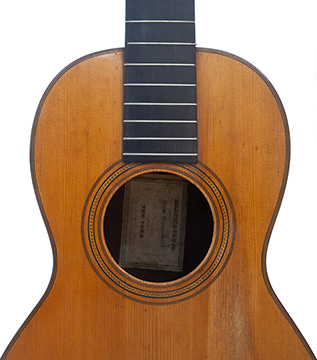
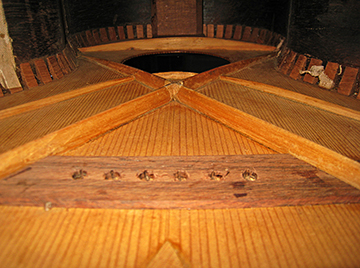
Illustrated
in Carter "Acoustic Guitars and Other Fretted
Instruments":
"By 1839 Martin had moved his workshop from New York to
Pennsylvania, and this relatively plain example of a Martin
& Coupa guitar was
probably made at the new location. Note also the
squared off headstock with rear-facing tuning pegs rather
than the old Stauffer-influenced design."
Illustrated
in Washburn & Johnston, "Martin Guitars: An Illustrated
Celebration of America's Premier Guitarmaker" with Schmidt
& Maul Guitar:
"The mystery of which is the first X-braced guitar will
probably never be solved, but these two early candidates
were clearly made by builders who were
aware of each other and may have even been
acquaintances. The fact that two very similar guitars
- both sold in New York in the latter 1840's and
both made by German immigrants - have nearly identical
X-patterns under the top suggests that there was a
considerable pool of talent at work. Whether
X bracing was a concept shared among compatriots or pirated
by competitors is the only question left unanswered. (This)
guitar bears a Martin & Coupa
label, and Martin historian Mike Longworth's research into
insurance policies held by C.F. Martin Sr. on Coupa's 385
Broadway address suggests that
Martin had guitars there as late as 1851 and certainly for
several years before that. Regardless of which came
first, Martin was the firm that went on to
make X bracing a standard feature of the American guitar."
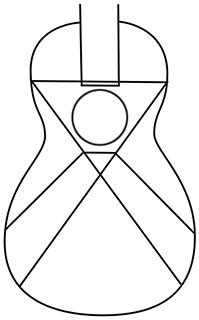
Chapter
13.
Ornate
Martin "DeGoni" Hybrid X Braced Guitar
The Martin produced for Madame DiGoni is one of several
that were rather plain, while some were quite
fancy. This example has a number
of high end features, including the jewel like rosette,
fancy marquetry side filets, and a few unique
features. This is a rare example with
marquetry on all borders. A handful of other
Martins have fancy wood marquetry on the top and side
borders, but surprisingly, not on the
back border as on this one. A handful of other
Martins have the headstock edge sheathed in ivory.
This rare example has a handsome contrast
of ivory sheathing on a black faced headstock, finished
off with pearl inlaid ivory pegs. Like other
Martins of the period, this example has
the faux Spanish foot and nickel silver nut. This
example also has an ivory pyramid style pyramid bridge
with the vestigal scooped back.
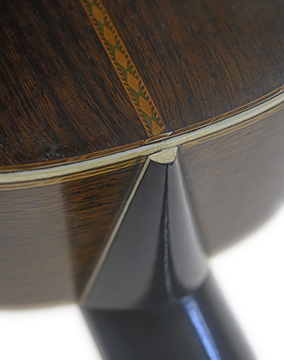
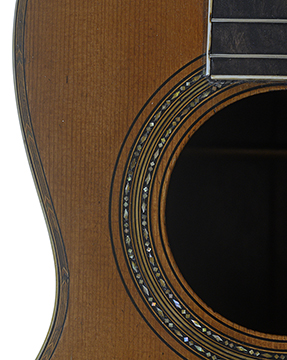
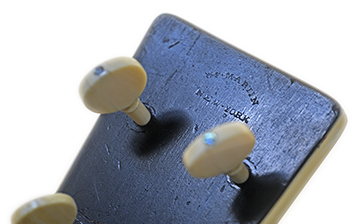

Chapter 14.
Schmidt & Maul 1847
Alternate X Braced Guitar
This Schmidt & Maul, dated 1847, has another experimental
form of bracing, consisting of fan braces, with three struts,
and a tone bar that extends past the
treble end of the bridge and across the treble strut to form a
small X under the treble side of the top.
The Schmidt & Maul contains many elements similar to the Martin, including herringbone trim,
a Spanish false foot, ebonized neck with ice cream cone
heel, ebony tie
style pyramid bridge with ivory inset, and a
similar company stamp on the upper back near the heel, not
surprising since Louis
Schmidt worked for Martin ten years earlier.
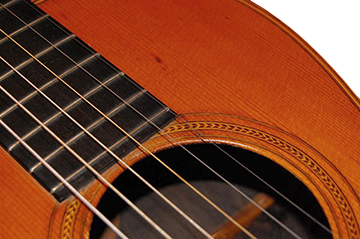
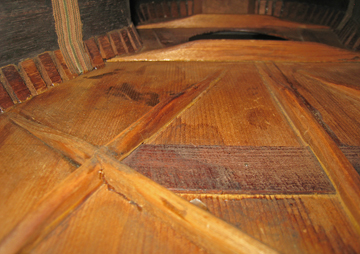
I suspect that this variation was an early one, as it contains
a complete three strutted fan, while the other variation, seen
on Martins, Martin & Coupas, and
Schmidt & Mauls, contain only the outer struts of the fan
in combination with a large X.
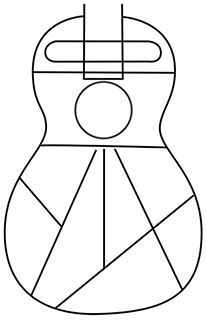
Chapter 15.
Size 3
"Small DiGoni"
Hybrid X
Braced Spanish
Martin Guitar
While the
instrument made
for Madame Di
Goni is thought
by some to be
Martin's first
X braced
guitar, this
size 3 Martin,
which fits the
description of a
"Small DiGoni"
has the same
hybrid of X and
fan bracing with
a number of
Spanish
influenced
features
that precede
those on the Di
Goni guitar,
which has no
features
indicating an
earlier
age..
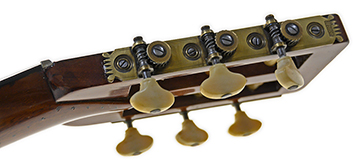
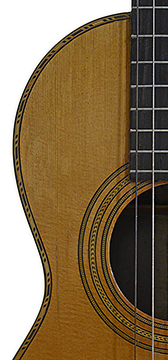

While Martin often
mixed older features
with newer ones,
this guitar, an
early version of a
Style 3-24, has an
early tie style
bridge rather
than a later pyramid
pin bridge, an early
elegantly curved
Spanish heel, a back
strip of straight
holly lines, an
early wide version
of the slotted
headstock with large
bone rollers, a
rosette more
reminiscent of a
Martin & Coupa
with tiny dentils,
rather than the more
standard Style 21
herringbone, and a
broad full 2" wide
neck width, along
with a faux Spanish
foot, and an earlier
rounded popsicle
brace.

Chapter 16.
Size 1 Hybrid X Braced
Spanish Martin Guitar
This Martin, with the exact same
experimental variation of X-bracing appearing on the Martin
& Coupa in Chapter 11, also has several distinctive
1840's
features, including a Spanish foot, Spanish heel, nickel
silver nut, and large abalone fretboard markers on the side
of the neck, as well as the colored diamond
backstrip, outer rosette rings with a tiny rope pattern, and
checkerboard binding sometimes seen on early Martins.
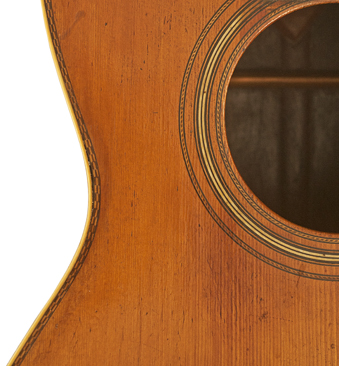
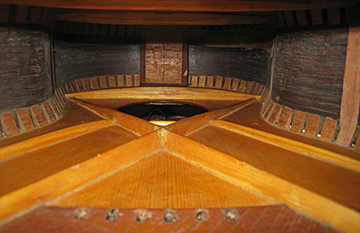
This early Spanish Style Martin
appears in a larger Size 1, with a variant of the classic
three ring soundhole rosette with double ivory center
rings that later distinguished the Style 28.

Chapter 17.
Early
Hybrid X Braced Schmidt & Maul Guitar
This
Schmidt & Maul also has the "Hybrid
X" bracing identical
to
that in the Martin & Coupa in
Chapter 11 and Martin in Chapter 13.
This instrument includes many of
Martin's features of the period,
including a Spanish cedar neck with
slotted headstock, a pin style pyramid
bridge, a Spanish
false foot, neck block and center strip
stamps, a three ring rosette with green
"tooth" inner ring and small "rope"
outer rings, "half arrowhead" marquetry
top and
side borders, and an "arrowhead"
marquetry back strip.
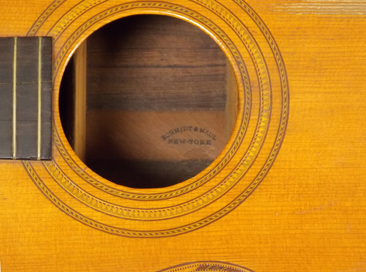
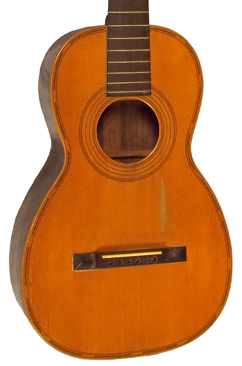
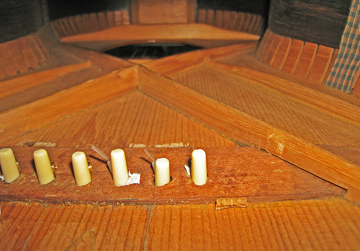

Chapter 18.
Martin Mid-1840's Alternate X
Brace Spanish Style Guitar
This Size 1 Martin has
another experimental variant of X bracing, similar
in concept the Schmidt & Maul in Chapter 12,
with a large X, and a tone bar below
the bridge crossing the treble brace of the X to form another, smaller
X. Following a similar
train of thought as
the Schmidt & Maul, with a tone bar crossing on the
treble
strut of the fan to form a smaller X, this appears to be
the first of the variants to contain a large, complete
X.

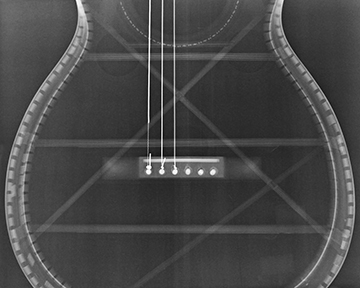
The soundhole of this guitar
has another variation of the diamond rosette, with a
tasteful single center ring of alternating long and
short abalone diamonds.
This example also has features typical of a mid-1840's Martin,
including a Spanish foot, Spanish heel, nickel silver
nut, large abalone fretboard markers
on the side of the neck, ebony pyramid bridge with a
"scooped" or "lipped" back, and a large diamond end
strip and outer rosette rings with a tiny rope pattern
of early Martins and arrowhead backstrip of later 19th
century Martins.
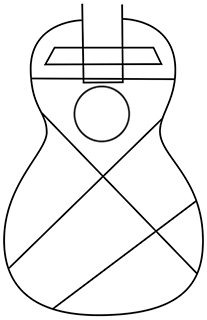
Chapter 19.
Martin Mid-1840's X
Braced Spanish Guitar
This Spanish Style guitar has been
called perhaps the earliest known Martin to feature a
mature X brace, essentially the same as it has appeared for many years since.
Still with the earliest typical Spanish features such
as cedar neck with Spanish heel, two piece
rosewood sides with a simple lengthwise center strip
dividing
the two pieces, distinctive holly binding, and simple
back strip with straight lines extending into the heel. The heel on this guitar is thicker and
not as elegantly
curved as on earlier examples, and the Spanish foot has
been eliminated.
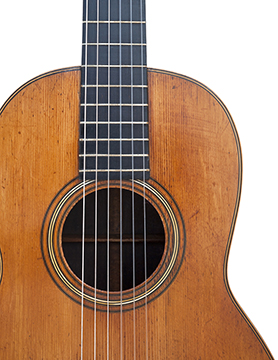
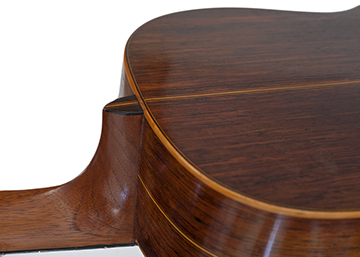
Bill Capell, from the essay "Early C.F. Martin Guitars":
"This is the earliest known
example of this style bracing that would go on to become
the standard for all modern acoustic guitars."
Images of this
important guitar were also included in the book
"Inventing the American Guitar: The Pre–Civil War
Innovations of C. F. Martin and His Contemporaries"
by Szego and Shaw, without the required permission,
and were erroneously attributed to the Martin
Collection, which has never owned this guitar.
The image and "likeness" of this guitar are the sole
property of the Corwin Collection, and may not be
legally reproduced without permission.
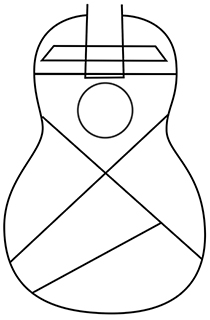
Chapter 20.
Martin
1840's Spanish Style Guitar with
Ebonized Spanish Neck
This
highly unusual guitar is the
only example of a Spanish Style
Martin known to have a Spanish
heel neck with an ebonized
finish and no volute, with the
exception of an early Martin
harp guitar who's ebonized neck
could easily have been designed
to match the ebony
support. This may be an
extremely early example, and
perhaps the first incarnation,
of a Spanish
neck Martin. Being
identical in many aspects to the
Martin in Chapter 11 with
"Hybrid X" Bracing, this is
likely to also be one of the
earliest examples of a Martin
with "mature X" bracing.
This is also an early example of
a Martin with a solid ring of
pearl in the rosette. Many
of the finer early Martins had
elegant decorative rings of
"white pearl" diamonds and/or
squares.
By the early 1850's, the jewel
like rings of pearl are replaced
by a thin central ring of solid
abalone. This example has
an elegant, somewhat wider 7/64"
solid ring of pure "White Japan
Pearl", most likely a transition
from the white pearl diamonds
and squares, to the 5/64" wide
solid abalone ring found on the
standard Style 27 and Style 30
and higher Martins.
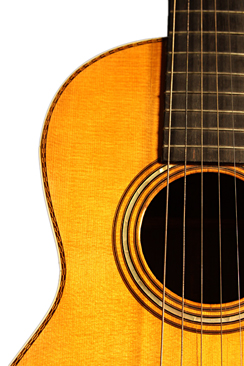
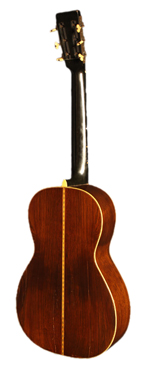
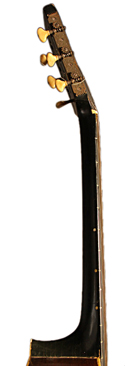
George
Gruhn:
"An
incredibly rare and historically
significant instrument. I do not
recall having seen any with a Spanish
heel, lack of a volute on the back the
peghead, and black neck finish like this
one."

Chapter 21.
Martin
1840's Mahogany Size 3 Guitar
C.F. Martin Sr. did not generally use
mahogany for backs and sides of his
guitars, choosing instead Brazilian
Rosewood, maple, and even
"Tigerwood". The first cataloged
model with mahogany was the Style 17
when it was reintroduced in 1906 by
Frank Henry Martin.
In the 1840's,
however,
before standardizing models, Martin did
build a number of Size 3 guitars selling
for $16 with mahogany backs and sides.
The typical $16 size 3 Martin had no
binding on the back.
This highly unusual example has a rare
combination of ebonized neck with a
solid headstock and pegs, beautiful
figured mahogany,
rosewood
fingerboard,
and fancy binding
on the back, as well as a Martin stamp
on the upper back, an original scooped
back pyramid bridge, and strap pin on
the back.
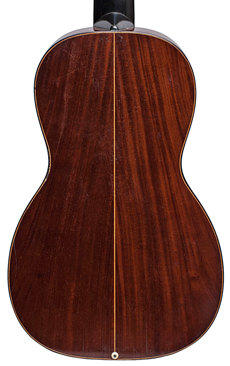
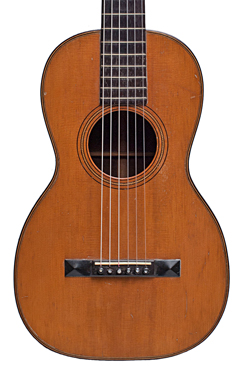
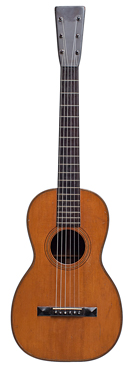

Chapter 22.
Martin 1850's
Ivory Fingerboard Stauffer/Spanish Style X Braced
Guitar
Martin sometimes held
over features for many years, offering guitars with
a mix of features from many periods on
request. One such set of features is
the Stauffer Style headstock with Vienna gears on an
ebonized neck with ice cream cone heel. This
fancy, small size 3 presentation guitar with ivory clad
fingerboard and Vienna gears was most likely built in the 1850's.
This example has the third of
the three basic pearl diamond soundhole designs, with twin bands of
tiny alternating long and short pearl diamonds, as
well as fancy wood marquetry on the top border and on the sides adjacent to the
top and back binding, and rare, gold plated
frets. With beautiful Brazilian
rosewood veneer over spruce on the back, the earliest
features such as the ebonized neck and ice cream cone heel are
combined with mature X braces.
The back is a rosewood veneer over spruce.
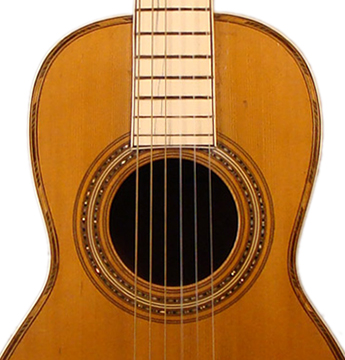
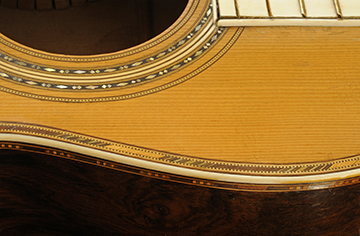
Illustrated
in Bacon, "History of the American Guitar":
"Gradually, Christian Martin
began to bring to the guitars he made more of his own
ideas on construction and design. The most obvious
visual
change when comparing this example to the earlier
Stauffer-style is the narrower upper body, giving an
overall shape that is more like a modern guitar."
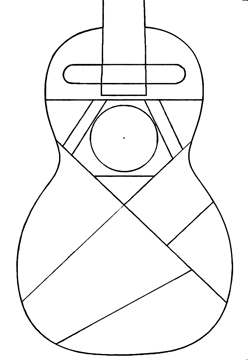
Chapter 23.
Martin
1850's Pearl Rosette and Pendant Guitar
This
final example combines decorative details typically
found on earlier Martins with construction elements
that would be standard for years to come. With
a beautiful decorative pearl rosette that is
possibly one of the earliest examples to contain a
version of the continuous thin band of pearl seen on
the rosettes and
borders of pearl Martins until WWII replacing the
rows of tiny pearl diamonds found on the finer
Martins of the mid-1800's, and an abalone pendant
similar to
the ones adorning the bridges of early Hudson St.
Martins. The guitar is spruce lined. The
Jerome tuners, with uncommon, large bone rollers,
have intricately
carved pearl buttons of the type appearing on only
the smallest handful of Martin guitars, while more
typically seen on ornate 19th Century presentation
banjos.
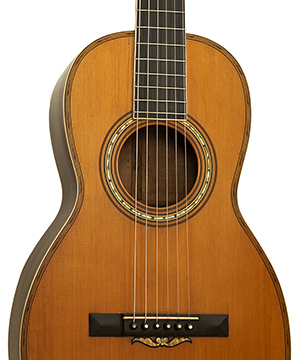
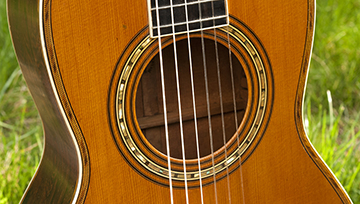
The body is a size 2 1/2, and the basic appointments
follow the form of a Style 30, making this perhaps a
$32 guitar. This guitar is possibly one of
the last before Martin models would become
standardized.

Chapter 24.
Henry Schatz, Boston
In the second half of the 1840's, after working
with Martin in Pennsylvania, Henry (Heinrich)
Schatz moved to Boston where he
produced guitars under his own name.
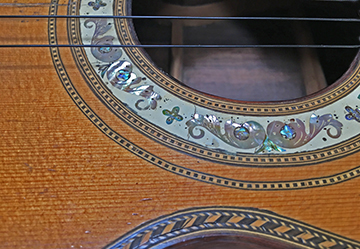
This is one of a number of Schatz guitars with
pearl inlaid in a white mastic, as opposed to the
black mastic used in the Martins he helped
produce in the previous decade, creating a
distinctly different effect.
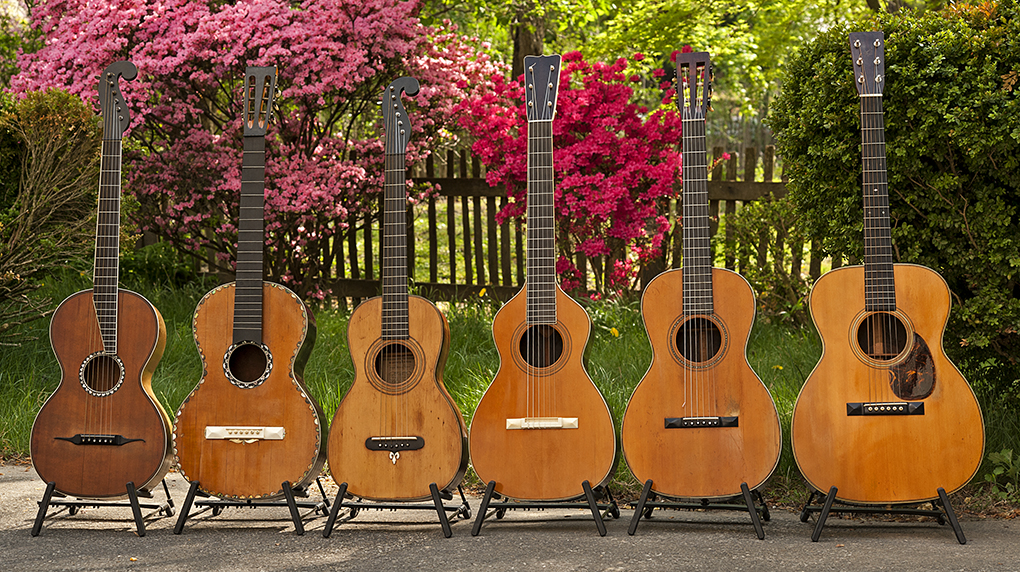
' ' ' ' ' ' ' '
' ' ' ' ' ' ' '
~ PART 2 ~
~ Defining
the Acoustic Guitar in the 20th Century ~
~ DEVELOPING THE CONTEMPORARY STEEL STRING
GUITAR ~
Chapter 25.
Martin
1902 00-42S / Style 45 Prototype
In 1902, three custom ordered Style 42 guitars
were built with pearl inlay added to the border of
the sides and back, as well as having an inlaid
"fern"
design added to the peghead. The first of
these had a fancy inlaid pickguard of the style
common on the higher end Martin mandolins of the
time, and an
intricate vine pattern inlaid on the
fretboard.
The example below was the first to have the more
prototypical fingerboard inlays of the type seen
in 1904 when this design was introduced as the C.
F. Martin Style 45 Guitar.
More on Style 45
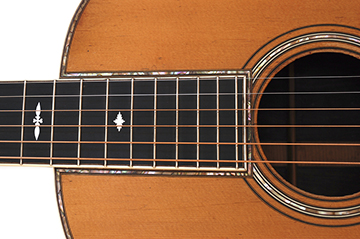
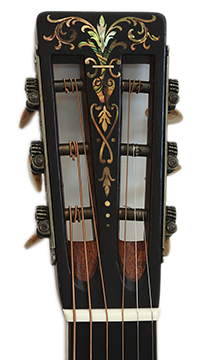
Illustrated on p. 2 & 28 of
Johnston, Boak & Longworth, "Martin Guitars, a
Technical Reference"
Subject of full page article by George Gruhn and
Walter Carter on page 42 of May, 2008 Vintage
Guitar Magazine
"This 1902 guitar features the first
version of the Style 45 peghead inlay, which is
sometimes referred to as the “fern” pattern.
Martin pictured a
Style 45 guitar with this inlay in the 1904
catalog and the same photo appeared as late as the
1909 catalog, but Martin had actually begun using
a simpler pattern, known today as the “torch,” by
1905, and that version lasted until about 1927."
"The initial designation – Style 42 special –
understated just how special Style 45 Martins
would become. In the pre-World War II years, it
was
only surpassed briefly by the OM-45 Deluxe
(produced only in 1930), which featured additional
inlays in the pickguard and bridge. In today’s
vintage market, Style 45s follow the same pattern
as they did in their original listings."
"Although Martin has offered models in recent
years with higher model numbers than Style 45,
along with many limited-edition, commemorative or
artist
models with fancier appointments, Style 45 remains
today as it was when this “pre-45” guitar helped
to get the Style 45 ball rolling – simply Martin’s
top style."
Chapter 26.
Martin 1902
000-21 10 String / Martin Grows in Size to a 000
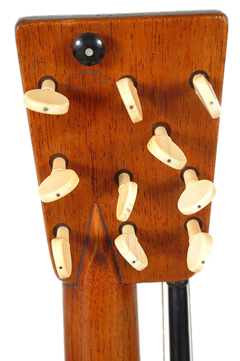
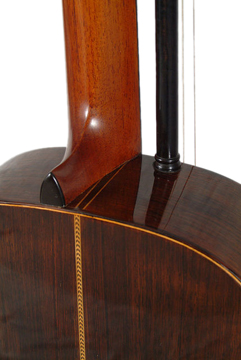
I look for important transitional guitars for this
web site to illustrate the development of the steel
string guitar, and this is an essential one. As a
harp guitar, or
more accurately, a "10 string 000-21" ( Martin only
used the term "Harp guitar" to refer to instruments with
2 complete necks )
this is a curiosity, although a
fabulous one.
More importantly, this instrument plays an integral
part in illustrating the history of the 000 size
Martin. This guitar was the first 10
string 000-21 designated as a 000,
making it the second Martin of any
type ever designated as a "000" size
Martin.
In
January 1901, Martin built an "Extra Large Style 21"
with a 15" wide body that was 5'16" deeper than what
became a standard 000, followed by an extra large 10
string guitar.
In 1902, Martin built one 9 string 00-21, and
shortly after, built a 10 string 000-28 followed by
two 10 string 000-21, apparently believing that the
000 size body was necessary
to accommodate the wider bridge needed for a 10
string guitar.
The 000 was slow to catch on as a standard size.
In 1903, Martin built a single "standard" 000-21,
their first six string 000, and three more were
built in 1904.
From 1902 to 1910, Martin built only 23 "000" size
guitars. Ten were "harp guitars". In 1907 and 1908,
the only 000 built was a 000-45 Harp guitar.
In total, only 13 standard six string "000" size
guitars were built in these first nine years.
Illustrated on p.84 of Washburn & Johnston,
"Martin Guitars: An Illustrated Celebration of
America's Premier Guitarmaker"
Subject of a full page article by Richard Johnston
on page 106 of July, 1997 Acoustic Guitar Magazine
Chapter 27.
The 000 Expands
Chapter 28.
Martin 1905 00-42S with
Pearl Fingerboard
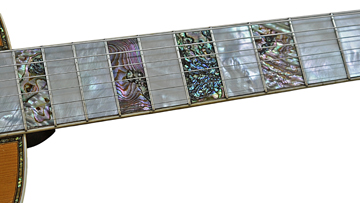
This
singular original example disproves
the myth that C.F. Martin, unlike
their competitors, never lavishly
embellished their fingerboards with
pearl.
Entire fingerboard made of genuine
white pearl, with intensely designed
abalone on frets five, seven, nine,
and twelve.
Subject of a full page article by
George Gruhn and Walter Carter on
page 42 of February, 2009 issue of
"Vintage Guitar Magazine".
Chapter 29.
Responding to the "Hawaiian Craze" with Martin's
First Production Steel String Guitars
Southern California Music
Company Guitars
Martin 1916
Southern California Music "Rolando" Model 1350
Prototype
No serial number
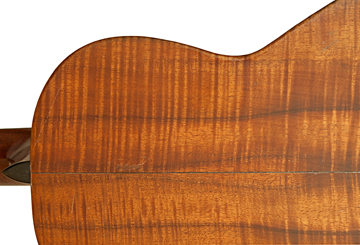
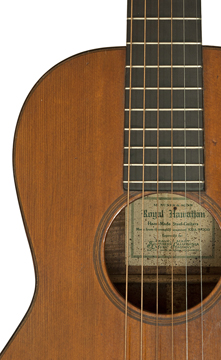
One of six
samples made for the California Musical Instrument
Company, the first Hawaiian Guitars made by the
Martin Company.
To meet the demands of the "Hawaiian Craze", Martin
built three models of Hawaiian guitars with koa wood
supplied by SoCal. The first samples were made
with spruce tops.
Thefirst batch of production guitars used koa for
the tops as well, and introduced specially
designated serial numbers taking into account the
early samples previously produced.
Chapter
30.
Production SoCal Guitars
Martin 1916
Southern California Music "Nunes" Model 1400
Serial number
28
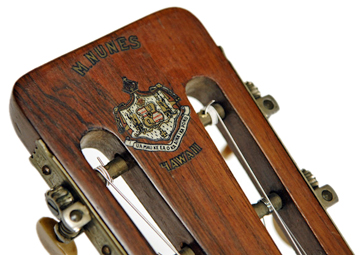


The first production "Nunes" Model 1400 made for
the Southern
California Music Company
in 1916.
Illustrated on p.113 of Washburn &
Johnston, "Martin Guitars: An Illustrated Celebration of
America's Premier Guitarmaker"
Illustrated on p. 247 of Johnston, Boak & Longworth,
"Martin Guitars, a Technical Reference"
Martin 1916 Southern
California Music "Rolando" Model 1500
Serial number 181
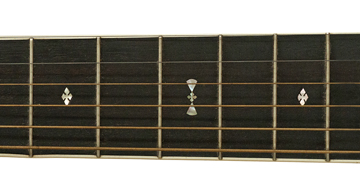
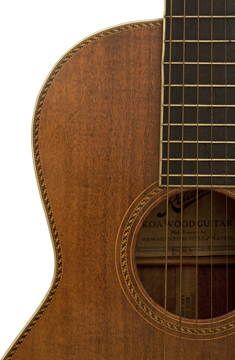
Chapter 31.
Martin Develops the Dreadnaught
Ditson Ukes
Martin 1916
Ditson Style 3 Ukulele
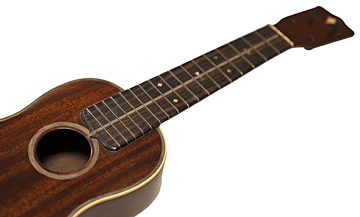
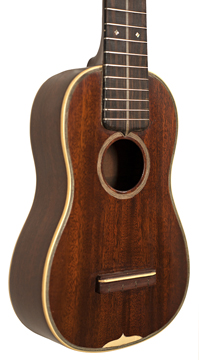
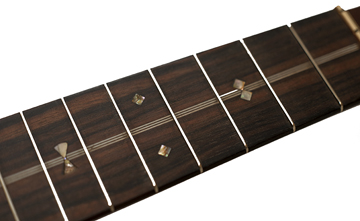
In the early 20th Century
the Ditson Company operated the Oliver
Ditson & Co. Store in their home
base of Boston as well as the Charles
H. Ditson & Co. Store in New
York. Ditson was a large Martin
dealer that ordered many standard
Martin models as well as special
models designed specifically for
Ditson. The Ditson stamp was
applied to both the regular Martin
models, otherwise identical to Martin
instruments sold elsewhere, and the
special Ditson "Dreadnaught" guitars.
Martin used the Dreadnaught shape on
ukuleles and tipples as well as
guitars in three sizes, defined by
Model designations with one, two, or
three digits, and three levels of
trim, designated as 1, 2, and 3.
The Dreadnaught guitars were
originally Hawaiian guitars which,
interestingly, used fan bracing to
support their steel strings, as did
the Hawaiian guitars built for the
Southern California Music Company.
Note that on this website uses the
traditional spelling of "Dreadnaught" with an "A",
since we are speaking here of pre-war examples, as
opposed to the more recent spelling of "Dreadnought"
with an "O", as commonly used today, but only since
it's adoption in the 1960's.
Chapter 32.
Ditson Hawaiian Guitars
Besides the standard range of Ditson Hawaiian
Guitars, Martin produced a small number of the
distinctively shaped Ditson Standard Guitars with
the appointments of typical Martin Styles 18, 21,
28, 30, 42, and 45. The 1-45 is often referred
to as a "baby D-45".
This is one of 26 Ditson Standard Style 21 guitars.
Martin 1917 Ditson DS-21 (1-21)
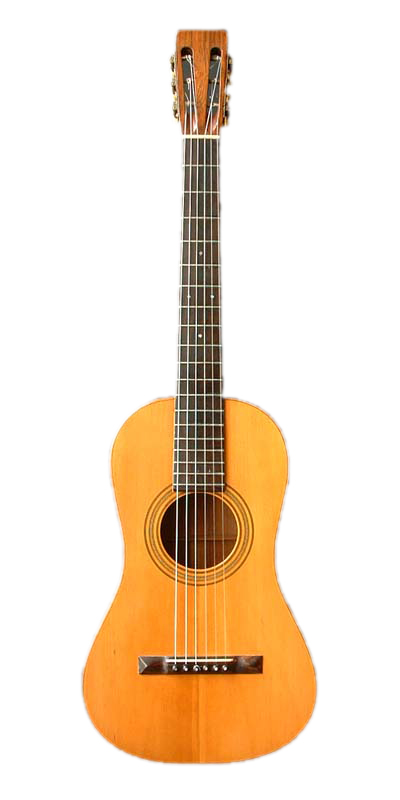
Martin 1916
Ditson Model 11
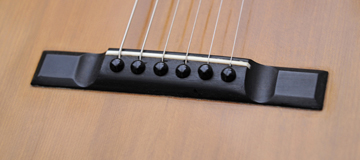
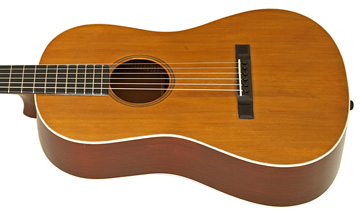
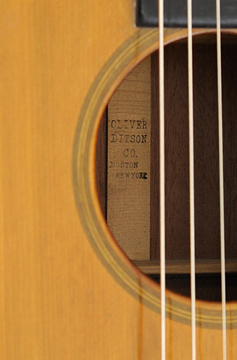
With the tremendous demand in production in 1916,
Martin sourced Chicago style bridges for the early
Ditson guitars.
Martin 1920 Ditson Model 33
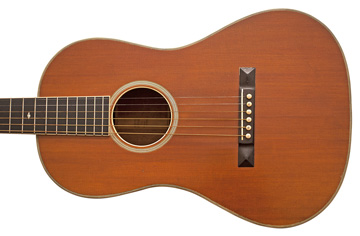

Martin
1919 Ditson 3/4 Size
Terz Guitar

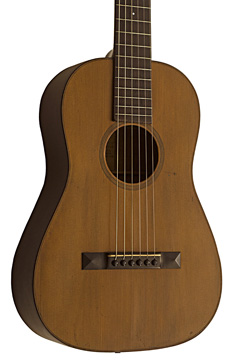
One of two 3/4 size
guitars made for the
Ditson Company that were
likely the prototype for
the "Travel Guitars" of
today.
Chapter
33.
Martin Learns from the Teachers
Martin 1916 Foden Special Models
C, D and E
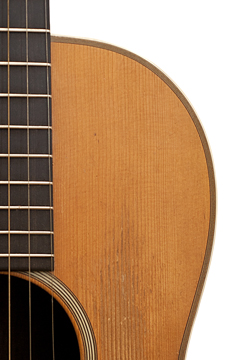
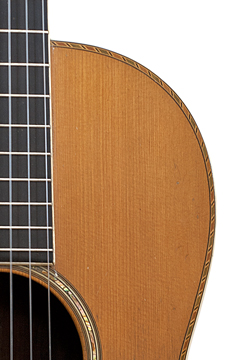
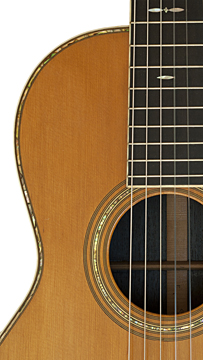
William Foden ordered guitars with several levels of trim for
his students.
The Style E combines the fretboard extension with no pearl of a
Style 40 with the inlays on the backs and sides of a Style
45. The Style E also used the same
"propeller" fingerboard inlay found on the SoCal 1500.
It is said that Foden was the first to request 20 fret necks for
his guitars, but I've also noticed several Martins made in 1902
with 20 fret necks.
Martin used single ring rosettes for the Foden guitars similar
to those used for Ditson, Wurlitzer, and other private label
guitars, but not on the top of the line Style E.
Chapter 34.
Martin 1922 Vahdah Olcott-Bickford
Style 0-44 Soloist
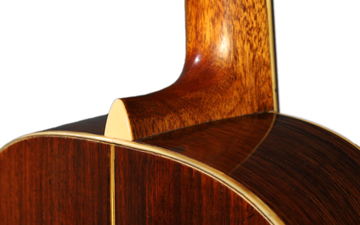
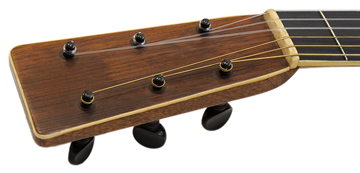
Vahdah Olcott-Bickford requested the finest Style 45
level material in the guitars she ordered for her
students, but shunned ostentation, ordering guitars
with simple
straight line borders and no fingerboard inlays.
Chapter 35.
The Model America
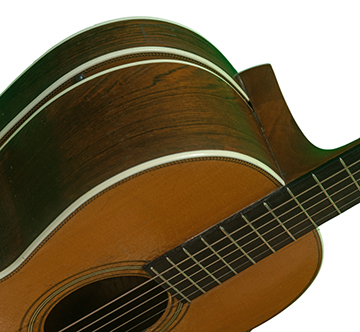
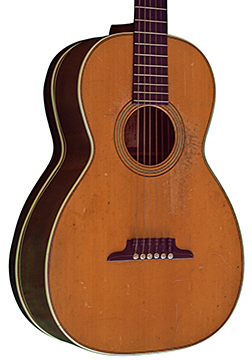
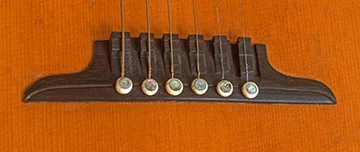
Chapter 36.
Pearl Makes the Transition from the "Ladies Parlor"
to the Stage
Martin 1918 Ditson 000-42
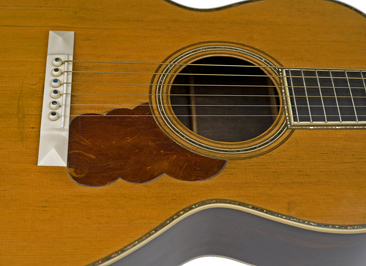
 In 1918 Martin produced the first
two 000 size guitars with their top of the line 42 style trim.
In 1918 Martin produced the first
two 000 size guitars with their top of the line 42 style trim.
From the earliest years, Martin used fancy pearl inlays to
adorn "ladies size"parlor guitars. The idea of adding
pearl to a "man's" guitar must have seemed
unthinkable at the time.
The 1918 000-42 illustrated here was built for the Ditson
Company as a steel string Hawaiian guitar
with fan bracing, the same build as a "Ditson
Dreadnaught".
This guitar ends the myth that steel strings were never
meant to be used with a pyramid bridge, never mind one
made of ivory!
This guitar is an early example of a Martin with a
pickguard. The early guards were inlaid into the
top.
Illustrated on p. 41 of Johnston, Boak & Longworth "Martin
Guitars, a Technical Reference"
Chapter 37.
An Early
First Appearance of Western Spruce
Martin 1919 0-45
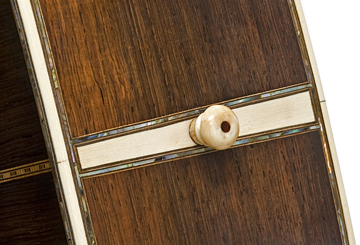
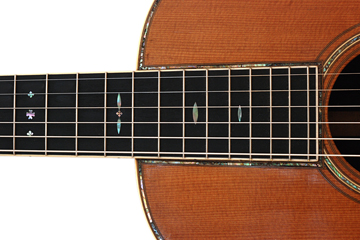
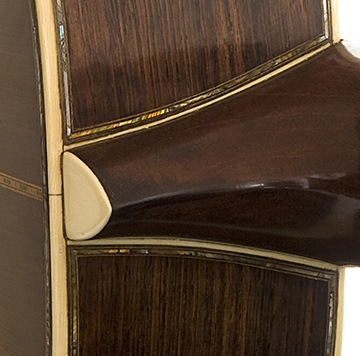
In 1945 Martin began to have difficulty sourcing
suitable Eastern red spruce of suitable size for
guitar tops and switched to the huge Western Sitka
trees for top wood.
It is little known, however, that in 1919 Martin
experimented with the use of what was then referred
to as "airplane spruce" for guitar tops. By
the time World War II ended
in November, 1918, production of Sitka spruce for
aircraft by the Spruce Production Division of the
Army had reached 10,000 sq. ft. per month, and left
the newly built
infrastructure and 1 billion board feet of Spruce.
Illustrated on p. 80 of Johnston, Boak &
Longworth, "Martin Guitars, a Technical Reference"
Chapter 38.
Martin 2-45
Chapter 39.
Martin Ships it's First Production Steel String
"Spanish" Guitar
Martin 1922 2-17 With Steel Strings
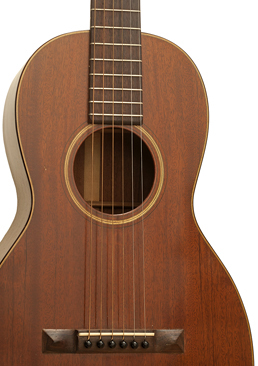
The first Martin guitars to ship with steel strings were the
Hawaiian guitars built for the Ditson and Southern California
Music Companies.
In 1922, Martin built the all mahogany model 2-17 with steel
strings, the first production steel string Martins for standard
"Spanish" style guitar.
Martin began the process of shipping their standard guitars with
steel strings as standard equipment with two Martin Style 2-17
guitars, #16879 and #16887, shipped to the John Wanamaker
Department Store in Philadelphia on March 27, 1922.
This guitar is #16879.
Chapter 40.
Martin's Experiments Resonate
1930 Wm. L. Lange Paramount Style L Hawaiian Six
String and Tenor Resonator Guitars
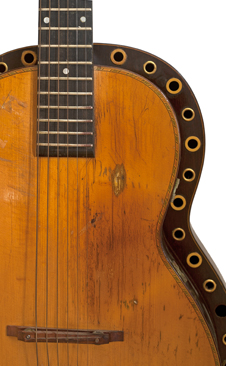
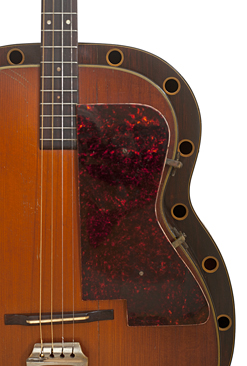
Martin made approximately 32 resonator guitars in 1930 with the
Paramount name for William Lange.
The Paramount Guitar was offered in three styles, all built with a
double rosewood body:
Regular Spanish Guitar, a Hawaiian Steel Guitar, and a Tenor
Guitar
These guitars varied greatly, some natural top and some shaded
tops, some with pickguards and some without, some with soundholes,
but most without.
The Tenor and Hawaiian Styles both had a moveable bridge and fixed
tailpiece. The Spanish Style guitar had a permanent ebony
bridge with ivory saddle.
Chapter 41.
Martin Enters the Market for Catalog Guitars
Martin 1030 Montgomery Wards 0-17S
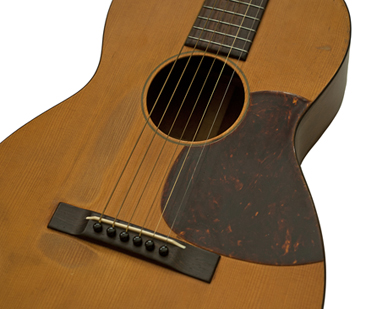
While Gibson and other large makers built many
Recording King and other guitars for the lucrative
Montgomery Ward Catalog market, Martin built only a
few small
batches of this distinctive model, the 0-17S, for
Montgomery Ward
Chapter 42.
Developing the Contemporary 14 Fret
Guitar
Chapter 43.
The first 14 Fret
The Carl Fischer Tenor
Martin
1929 Carl Fischer
Model Tenor Guitar
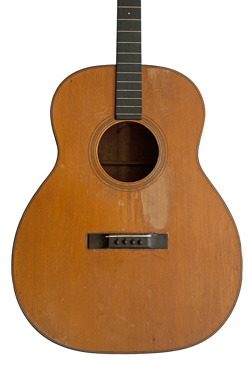
Credit for the 14
fret Martin design has
been given to Perry
Bechtel, the buyer for
the Cable Music Company
in Atlanta who requested
the 14 fret OM
guitar.
In fact, it was Al
Esposito of the Carl
Fischer Store in New
York City who first
requested a 14 fret
design for tenor guitars
as suggested by two
local orchestra leaders
to appeal to banjo
players. Mr.
Bechtel's contribution
consisted primarily of
going fishing with Mr.
Martin. When
Bechtel showed up to
meet Mr. Martin for
their fishing
trip, he noticed the
Fischer Model tenor
guitars on the factory
floor, and asked if the
same could be done with
six strings to give
greater access higher on
the neck.
Chapter 44.
The Orchestra Model
Martin 1929 000-28 - 12 fret
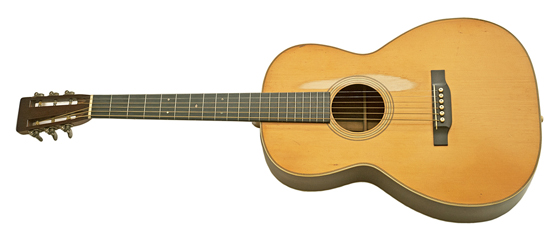
Martin considered the 12 fret design to have a
superior sound, but understood the practicality of
the 14 fret guitar.
Martin 1929
00-28 G.P.
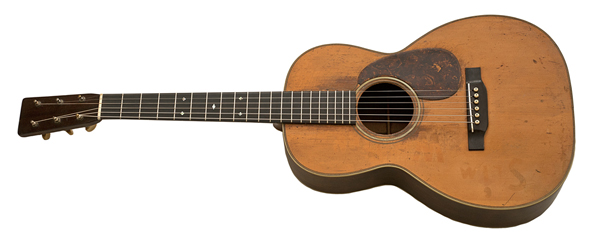
Martin built a small number of transitional guitars,
such as this "00-28 G.P.", for "geared pegs", which
still had a 12 fret body, but had the solid style
headstock and
"banjo style tuners" of the OM. Pickguards and
"belly bridges" were not used until 1930, but many
Martins built before 1930 sat in the factory unsold,
unfinished,
"in the white", due to the slow economy of the time, and were given a tortoise
Celluloid pickguard and "belly bridge"
before leaving the factory in the
following years.
Martin 1930
OM-18P Plectrum Guitar
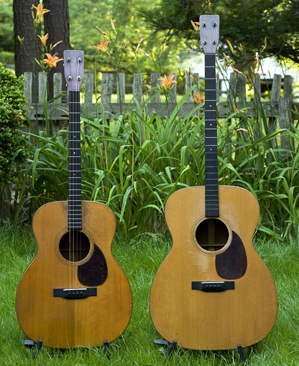
To appeal to long neck banjo players, Martin also began to produce
a long neck plectrum guitar in the OM Style.
Featured on the Television Show "Pawn
Stars"
Martin 1930
OM-28
January, 1930
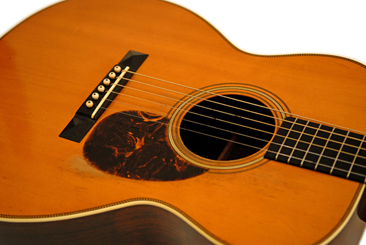
The first few OM guitars built for Cable Piano in
1929 and early 1930 had a pyramid bridge before the
belly bridge, generally associated with the
contemporary
flat top guitar, was used. The small teardrop
pickguard and banjo style tuners were soon replaced
by a larger pickguard and modern guitar tuners.
Chapter 45.
The Orchestra Model Expands
Martin 1932 O-18 and 1933 0-17 Model 32
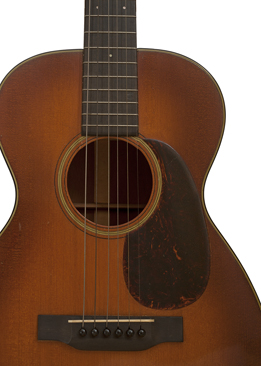
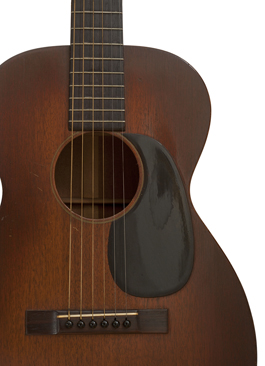
With the "Model 32" 0-17 and 0-18,
Martin extended the 14 fret body
further into the product line.
Chapter 46.
Taking Ornamentation to the Next Level
Martin
1930 OM-45 DeLuxe
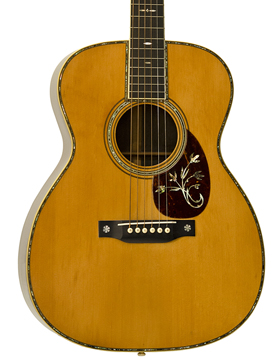
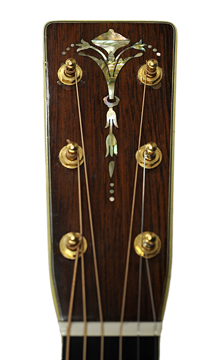
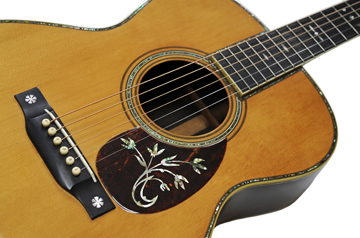
Featured in an article by Joe Konkoly
In 1930, Martin built only about a dozen "DeLuxe" style 45
guitars, the highest level production Martin to ever be made,
before shortages of the high quality materials forced Martin to
cancel all future orders after November 28th.
This example was built in September 25, 1930.
Chapter
47.
Martin Responds to the
Call for the Archtop
Guitar
Martin Archtop Guitars
The first Martin archtops
Martin 1931 C-1 Prototype - Martin's First Archtop
Guitar
Serial number 47368
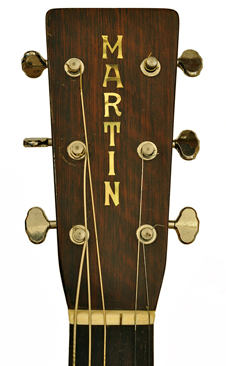
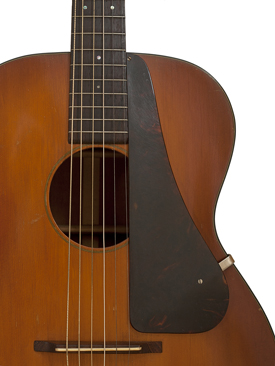
Chapter 48.
Martin 1933 R-18
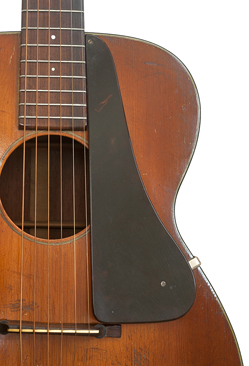
Chapter 49.
Martin 1932 C-2 12
String Archtop Guitar
Martin's first 12 String archtop guitar.
Serial number 50223
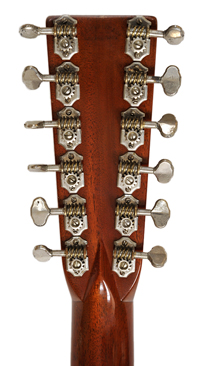
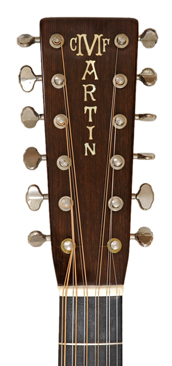
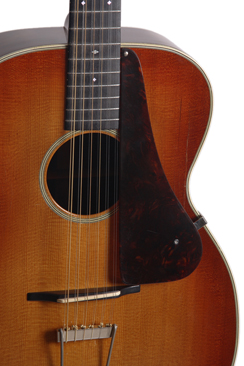
Illustrated on p. 172 of Johnston, Boak &
Longworth, "Martin Guitars, a Technical Reference"
Illustrated on p. 193 of Carter, "Acoustic Guitars
and Other Fretted Instruments"
Chapter 50.
The Last Martin Archtops
Martin 1942 F1
- from the last batch of Martin F Style Archtops -
Serial number 82431
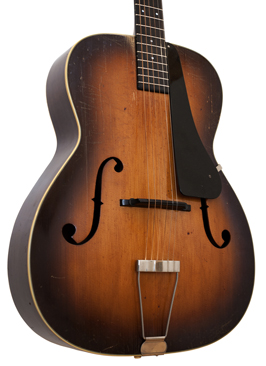
Martin 1942 R-18
- from the last batch of
Martin R Style Archtops -
the final Archtop Guitars built by
Martin
Serial number 82855
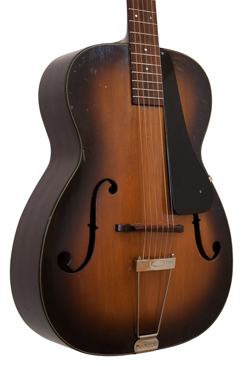
C. F.
Martin's interest in archtop guitars was relatively short lived,
beginning with the 15" carved top, round hole C-1 above, #47368,
and five other examples, the first archtop guitars ever to
grace the work tables at Martin, on June 20, 1931.
By November of 1932, the C-1 was first built with F-holes as it's
former position in the lineup was filled by the slightly smaller
14 3/8" pressed top roundhole R-18.
By the end of 1933, the R-18 had also become an "F" hole
guitar.
By mid-1936, the R-18 was also built with a carved top.
The F-1 and R-18 above, #8243
1 and #82855,
were from the last two batches of archtop guitars ever to be built
in Martin's North Street Factory, stamped on September 18 and
November 20 of 1942.
Before building flat top 12 string guitars in the 1960's, Martin
built only six individual 12 string guitars, three flat tops and
three arch tops.
The 12 string above, #50223, was the first 12 string arch top ever
built by Martin.
Chapter
51.
Responding to
the Limits of
War
Martin 1939 D-28
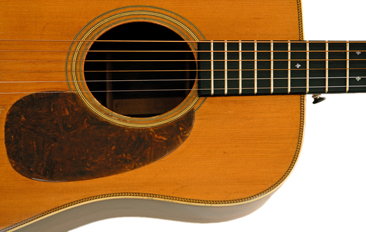
Martin 1944
D-18 - with scalloped bracing and red spruce
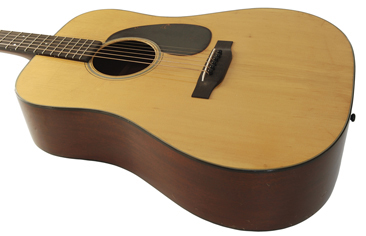
These examples illustrate the changes necessitated by shortages of
materials and personnel during the war years, as well as an effort
to build stronger guitars to handle heavier strings.
Due to strictly enforced limits to the amount of metal to be used,
the neck reinforcements in war time Martins returned from metal to
ebony rods similar to those used decades earlier,
necessitating a bulkier but lighter weight neck with a different
feel. The tuners were redesigned to use significantly less
metal, and the nut material changed from ivory to ebony, all of
which contributed to a change in balance as the "top end" of the
guitar became lighter in weight.
Due to a change in finish formulations, many of the guitars
produced in 1944 developed a cloudy problematic appearance,
necessitating in many examples being oversprayed.
On February 24, 1943, Martin built a batch of 000-42 guitars, the
last batch of pearl inlaid Style 40, 42, or 45 Martins. With
the last batch of D-28 in 1945 Martin exhausted their supply of
fingerboard inlays and began using dots. With the first
batch of D-28 in 1947, Martin exhauted their supply of Germand
made herringbone marquetry, and instituted the use on D-28
of the straight line borders first used on Martin's archtops.
Chapter 52.
Tapered Braces
Martin
1945 D-18
Martin 1946 000-18
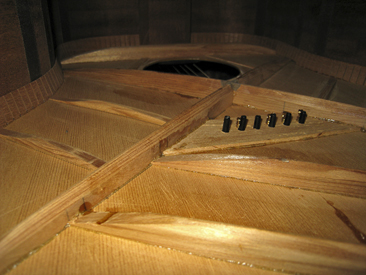
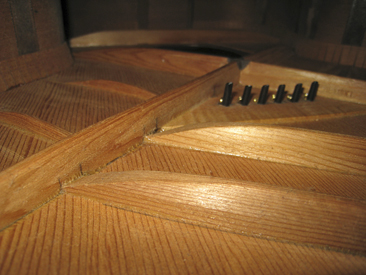
When old guitars became "vintage guitars", players looked more
carefully and noticed the "scalloped" top braces of pre-war
Martins, shaved to form peaks and valleys, as opposed to the
earlier "straight braces". More recently, folks have
noticed that "War Year" Martins have transitional "tapered"
braces.
Looking more closely, I've discovered that guitars built in
1945 are distinctively different from those of other war years,
with their braces considerably more tapered, creating a signature
loud and "punchy" sound. The photos above illustrate the
slender braces of 1945 in constrast to the heavier, rounder braces
of 1946. I would not be surprised if the more highly tapered
braces have even less mass than the scalloped braces of preceding
years.
Chapter
53.
Martin's First
Electric
Guitars
F-50 #180644 and
F-65 #179835
Electrics
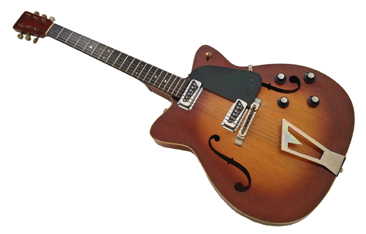
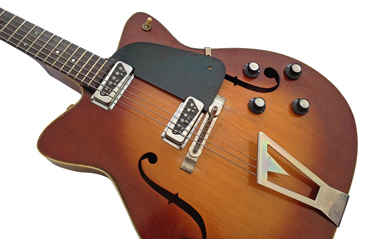
While Martin produced flat top guitars with DeArmond
pickups in the 1950's, in September of 1961 Martin
made their first freshly designed "thin body"
electric
guitars, starting with three prototypical examples
of each of three variations, of which this top of
the line, two pickup, double cutaway F-65 #179835
is
one. In
November of 1961, Martin produced the first
production run of 12 of each style, of which this
single cutaway, single pickup F-50 #180644
is
one.
Larger production in batches of 24 each began in
1962.
Chapter
54.
The NY Folk
Revival
0-16NY
00-21NY
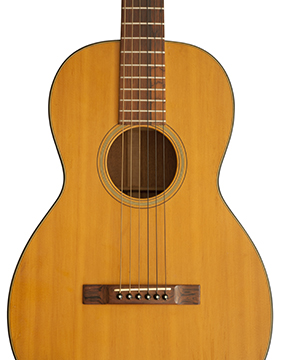 ' ' ' '
' ' ' ' ' ' '
' ' ' ' '
' ' ' '
' ' ' ' ' ' '
' ' ' ' '
~ PART 3 ~
~ FIRST FEATURES ~
The Introduction of Features
of the Contemporary Steel String Acoustic Guitar
Chapter 55.
Border Patrol
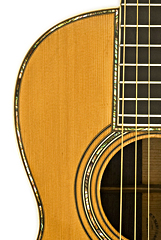
Chapter
56.
The Head of the Class
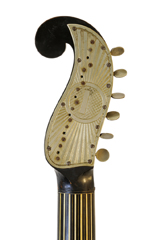
Chapter
57.
Tuner
Sandwich
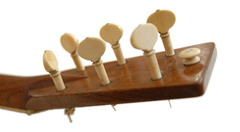
Chapter
58.
A Stamp of Approval
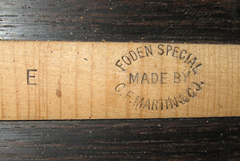
Chapter
59.
Pearl
Jam
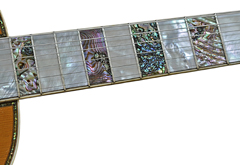
Chapter
60.
Arrowheads
and Other Hidden Treasures
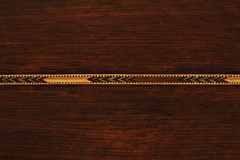
Chapter
61.
The
End Is Near
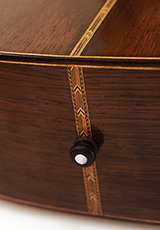
Chapter
62.
The Spanish Foot
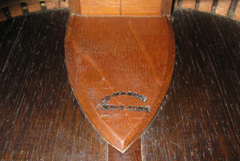
Chapter
63.
On
Guard!
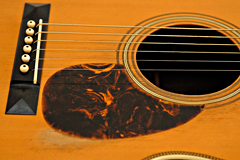
Chapter
64.
Speaking Volutes
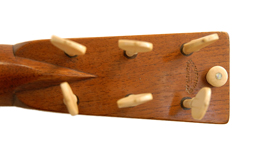
Chapter
65.
Feel Like a Heel
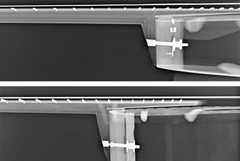
Chapter
66.
A Bridge to Somewhere
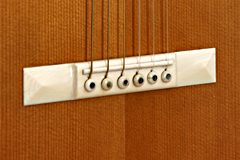
Chapter
67.
All Tied
Up
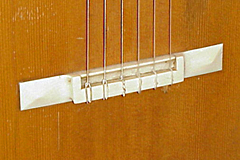 Chapter
69
Chapter
69.
Back in
the Saddle
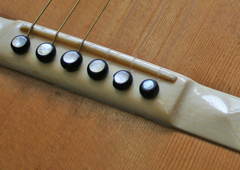 Chapter
70
Chapter
70.
Hear a Pin
Drop
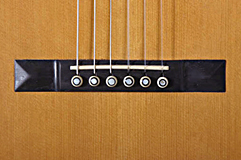 Chapter
71.
Nuts!!!
Chapter
71.
Nuts!!!
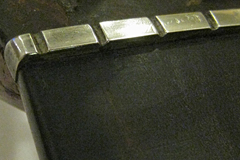 Chapter
72
Chapter
72.
Something
to Fret About
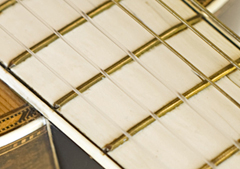 Chapter
73
Chapter
73.
Strung Out
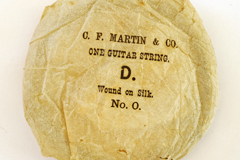
Chapter
74.
Photo Finish
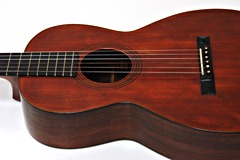
Chapter
75.
Knock
on Wood
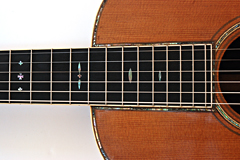
Chapter
76.
Does Size Matter?
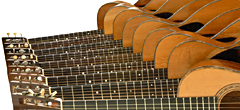
Chapter
77.
The Shape of Things to Come

Chapter
78.
We've Got Your Number
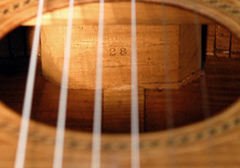
Chapter
79.
X Marks the Spot
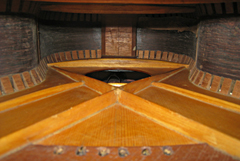 Chapter
80
Chapter
80.
Your
Biggest Fan
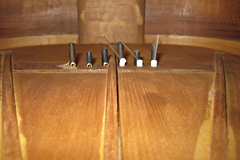
Chapter
81.
Safe at
Home Plate
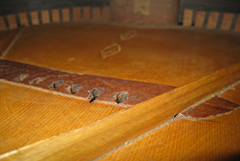
Chapter
82.
Case Closed
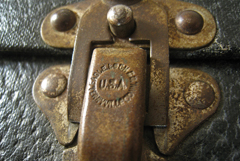
Chapter
83.
A Final Nail in the
Coffin
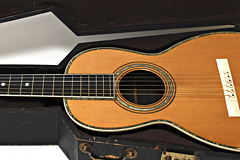
~ LATER DEVELOPMENTS ~
Chapter
84.
Tune Up
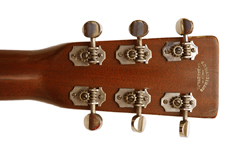
Chapter
85.
Hawaiian Punch
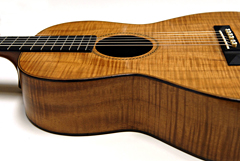
Chapter
86.
The Tenor of the Times
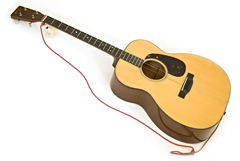
Chapter
87.
The Orchestra Model
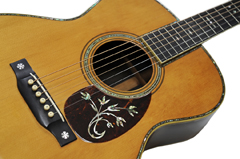
Chapter
88.
The Dreadnaught
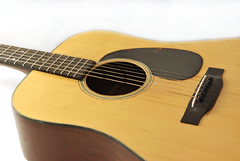
Chapter
89.
Double Your Fun
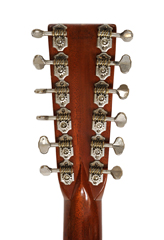
Chapter
90.
Classical Gas

' ' ' '
' ' ' ' ' ' '
' ' ' ' '
~ PART 4 ~
~ MARTIN STYLES ~
As They've Been Defined Since the 1850's
Chapter
91.
Styles 15, 17 & 18
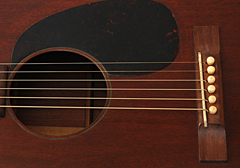
Chapter
92.
Styles 20, 21 & 22
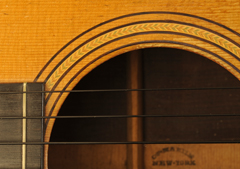
Chapter
93.
Styles 23 & 24
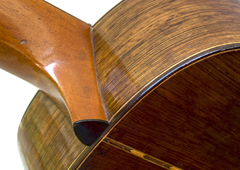
Chapter
94.
Styles 26 & 28
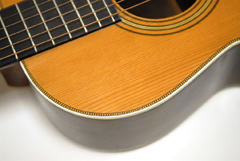
Chapter
95.
Styles 27, 30 & 34
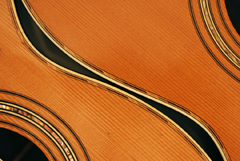
Chapter
96.
Style 35
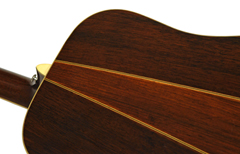
Chapter 97.
Styles 40 & 42

Chapter
98.
Style 45
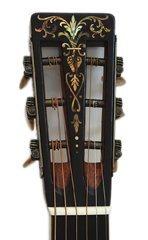
Chapter
99.
Style 45 DeLuxe

Chapter
100.
Martin Archtop Guitars
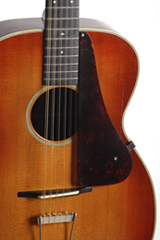
Chapter
101.
Martin Terz Guitars
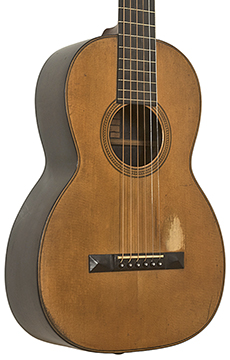
Chapter 102.
Martin Mandolins
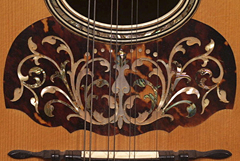
Chapter
103.
Tiple

Chapter 104.
Tarropatch
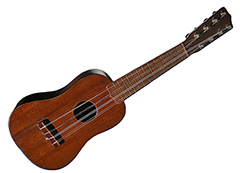
Chapter 105.
Harp Guitars
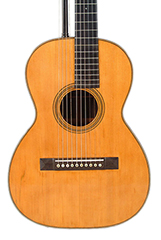
Chapter 106.
Martin Tenor Banjo

Chapter 107.
7 String Hawaiians
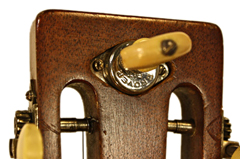
' ' ' '
' ' ' ' ' ' '
' ' ' ' '
~ PART 5 ~
~ MARTINS SPECIALLY MADE FOR OTHER FIRMS ~
Chapter
108.
Bacon Banjo Company 0-21
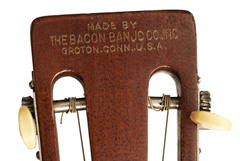
Chapter 109.
Buegeleisen
& Jacobson S.S.
Stewart 2-17 Special
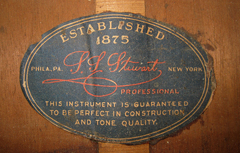
Chapter
110.
Oliver Ditson Company Style
2-17, Style 1-21, Style 2, Style 11, Style 22, Style 33, Style
111, and 3/4 Size
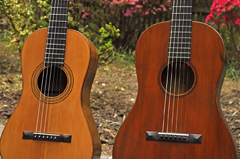
Chapter
111.
Carl Fischer Model Special
Tenor
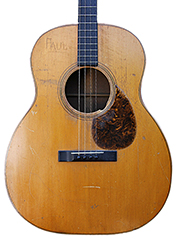
Chapter
112.
William Foden "Foden Special" Models
C, D, and E
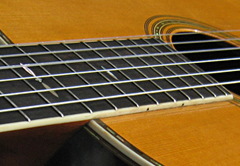
Chapter 113.
C.H.
Gaskin's Harp Mandolin
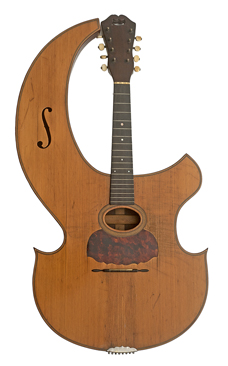
Chapter
114.
Grinnell
Brothers "Wolverine" 2-17 and 0-18

Chapter
115.
Wm. L. Lange Paramount
Style L Six String and Tenor Resonator Guitars
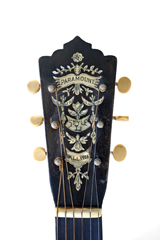
Chapter
116.
Montgomery Wards 0-17S

Chapter
117.
Vadah Olcott-Bickford Style
0-44 Soloist

Chapter
118
Perlburg &
Halpin "Beltone" 2-17
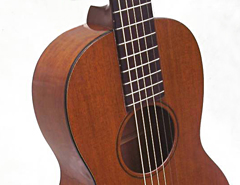
Chapter
119.
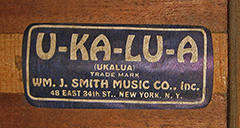
Chapter 120.
Southern California
Music Company 1350 and 1500 Samples, "Nunes" Styles 1350 &
1400 and "Rolando" Style 1500
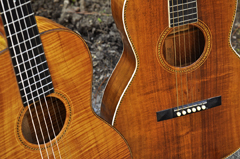
Chapter
121.
Rudolph Wurlitzer Styles
2087, 2088, and 2092
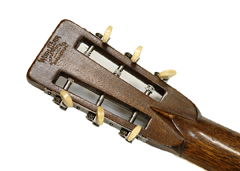
Chapter
122.
Bitting Special
Mandolin
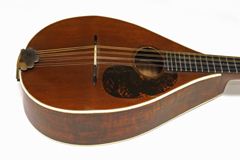
Chapter 123.
Briggs Special
Mandolin
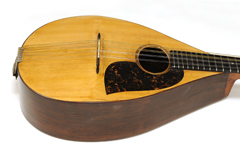
Chapter
124.
Ditson Style A Mandolin
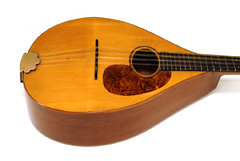
Chapter
125.
Ditson Standard
Style 1 and Dreadnaught Styles 1, 2, and 3 Ukuleles
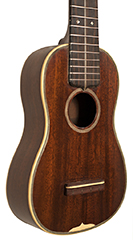
Chapter
126.
P. H. Louis Brachet Martin Zither
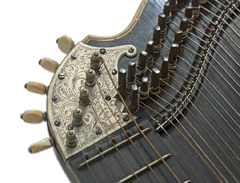
' ' ' '
' ' ' ' ' ' '
' ' ' ' '
~ PART 6
~
~ CHECKING OUT THE COMPETITION ~
Chapter
127.
James Ashborn Styles 1, 2, and 6
for William Hall & Son and Firth, Pond & Co.
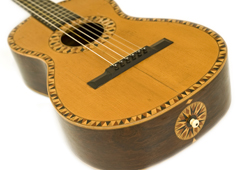
Chapter
128.
Joseph Bohmann Early
Presentation and Harp Guitars, and Guitar and Mandolin with
Interior Drone Strings
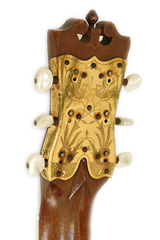
Chapter 129.
Dyer
Harp Guitars
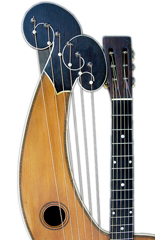
Chapter 130.
Orville Gibson
Guitars and Mandolins
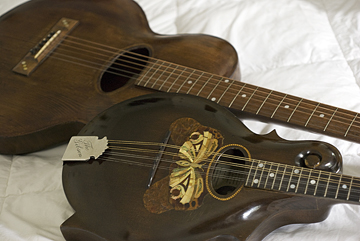
Chapter
131.
The Gibson
Company
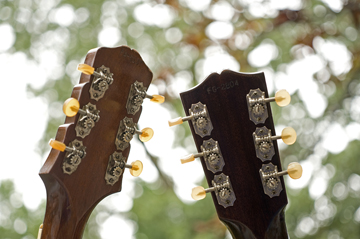
Chapter
132.
The Larson Brothers
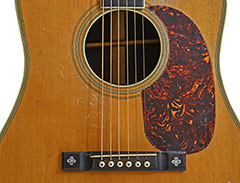
Chapter 133.
Louis Panormo

Chapter
134.
Jose Recio, Cadiz
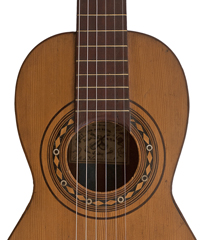
Chapter 135.
Rickenbacher,
Gibson and Other Early Electrics
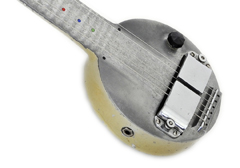 Chapter136.
Chapter136.
Schmidt
& Maul Guitars with fan and Experimental X Bracing
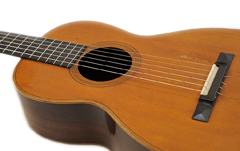
Chapter137.
Albert Shutt Style D#2
Mandolin
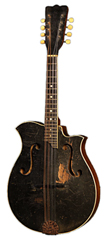
Chapter138.
Johann
Stauffer
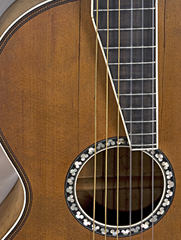
Chapter
139.
Tilton Improvement
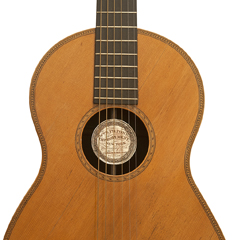
~ CLEANING HOUSE ~
If you would like to buy a nice Martin or Gibson
Guitar...
I love these, but I really need to make room for new ones.
Acoustic
Instruments for Sale
Electric
Instruments for Sale
I am not in the business of buying and selling
guitars, but am interested in purchasing specific unique
instruments to round out my collection to present you with a web
site with as complete a picture as possible to help you learn.
I am interested in substantially original examples made
from the 1800's to 1960's by Stauffer, Panormo, Schmidt
& Maul, C. F. Martin, Martin & Coupa, Martin &
Schatz, Martin & Bruno, Martin & Zoebisch, John Coupa, Oliver Ditson,
Southern California Music, John
Wanamaker, Wm. J. Smith, Wurlitzer, S.S.
Stewart, Orville Gibson, the Gibson Company, and the Larson
brothers. I am not hunting for bargains, but seeking
quality intstruments at a price that is fair to the buyer and
seller alike.
To see Robert's new web
site illustrating the development of the Early Martin Guitar,
from 1833 to 1898, visit:
earlymartin.com
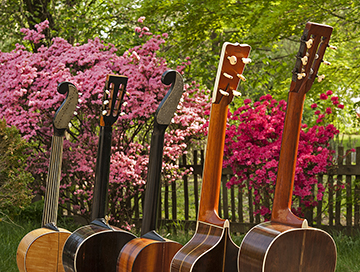
To see Robert's new web site illustrating the development of
the Early Gibson Guitar, visit:
earlygibson.com

To see Robert's new web site illustrating the development of
the post-Orville Gibson Guitar, visit:
oldgibson.com

To See Robert Corwin's Classic Photography of Folk and
Roots Musicians, visit:
robertcorwin.com

For Information on Photography for
Exhibition,
Publication, CD's, Promotion, Web Pages, Tour Books,
to Purchase
Photographic Prints, or
To Contact Robert
With Questions About An Early Martin Guitar:
e-mail: Robert Corwin
I'm more than happy to answer questions
to the best of my limited ability about features of the
instruments I've photographed and studied from
luthiers restoring vintage Martins or building new
instruments.
The Early Martin and Vintage Martin web pages were
first created in September, 2009.
Updated 1/1/20
Entire site copyright ©1998 through 2020 Robert
Corwin/Photo-Arts. All rights reserved.
Photographs and written material on this site may not be
reproduced without permission.




